|
PLearn 0.1
|
|
PLearn 0.1
|
Neural net, trained layer-wise to predict the manifold structure of the data. More...
#include <DeepNonLocalManifoldParzen.h>
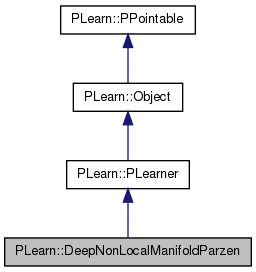
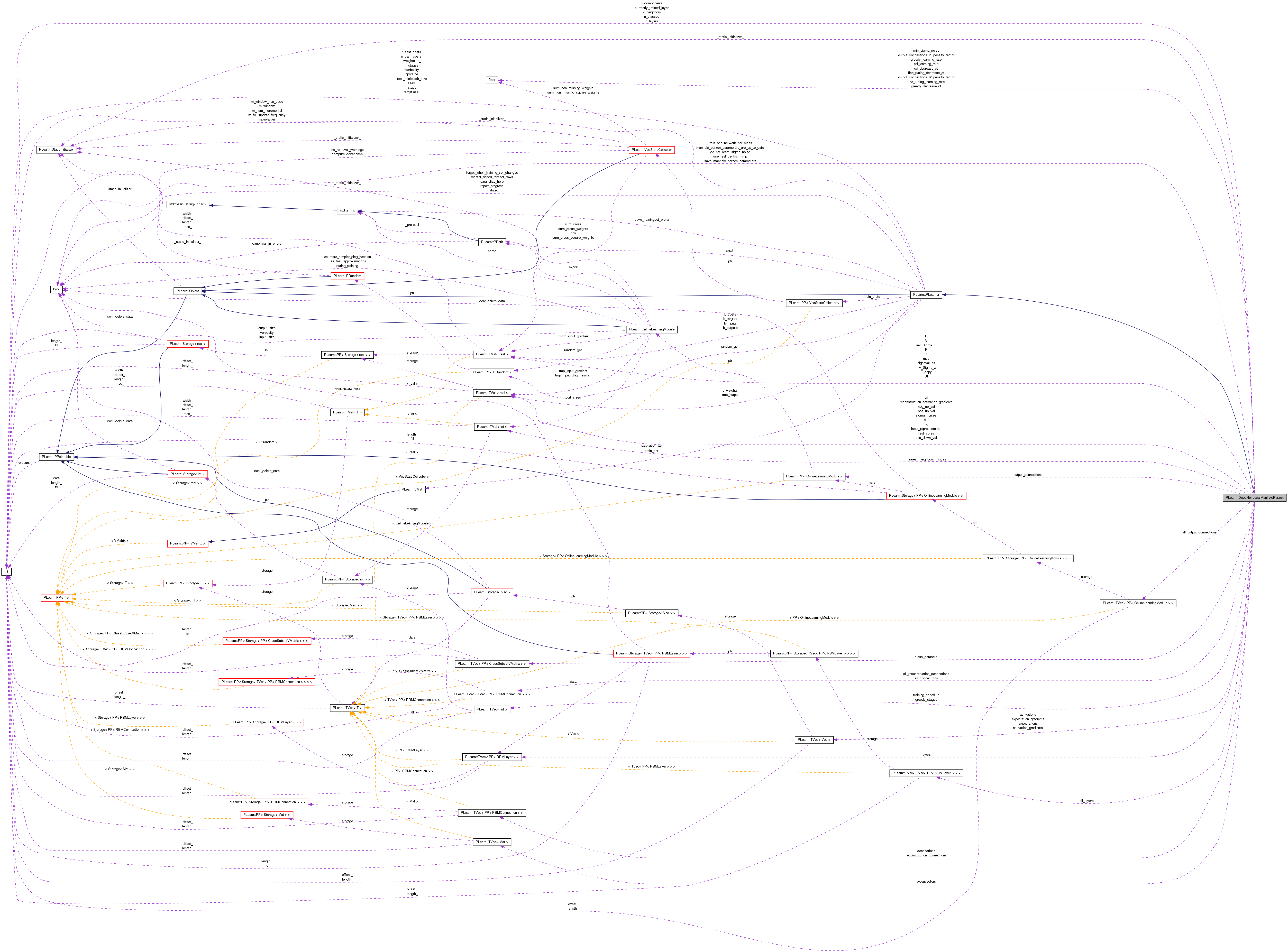
Public Member Functions | |
| DeepNonLocalManifoldParzen () | |
| Default constructor. | |
| virtual int | outputsize () const |
| Returns the size of this learner's output, (which typically may depend on its inputsize(), targetsize() and set options). | |
| virtual void | forget () |
| (Re-)initializes the PLearner in its fresh state (that state may depend on the 'seed' option) and sets 'stage' back to 0 (this is the stage of a fresh learner!). | |
| virtual void | train () |
| The role of the train method is to bring the learner up to stage==nstages, updating the train_stats collector with training costs measured on-line in the process. | |
| virtual void | computeOutput (const Vec &input, Vec &output) const |
| Computes the output from the input. | |
| virtual void | computeCostsFromOutputs (const Vec &input, const Vec &output, const Vec &target, Vec &costs) const |
| Computes the costs from already computed output. | |
| virtual void | updateManifoldParzenParameters () const |
| Precomputes the representations of the training set examples, to speed up nearest neighbors searches in that space. | |
| virtual TVec< std::string > | getTestCostNames () const |
| Returns the names of the costs computed by computeCostsFromOutpus (and thus the test method). | |
| virtual TVec< std::string > | getTrainCostNames () const |
| Returns the names of the objective costs that the train method computes and for which it updates the VecStatsCollector train_stats. | |
| virtual void | setTrainingSet (VMat training_set, bool call_forget=true) |
| Declares the training set. | |
| void | greedyStep (const Vec &input, const Vec &target, int index, Vec train_costs, int stage) |
| void | fineTuningStep (const Vec &input, const Vec &target, Vec &train_costs, Mat nearest_neighbors) |
| void | computeRepresentation (const Vec &input, Vec &representation, int layer) const |
| void | computeManifoldParzenParameters (const Vec &input, Mat &F, Vec &mu, Vec &pre_sigma_noise, Mat &U, Vec &sm_svd, int target_class=-1) const |
| virtual string | classname () const |
| virtual OptionList & | getOptionList () const |
| virtual OptionMap & | getOptionMap () const |
| virtual RemoteMethodMap & | getRemoteMethodMap () const |
| virtual DeepNonLocalManifoldParzen * | deepCopy (CopiesMap &copies) const |
| virtual void | build () |
| Finish building the object; just call inherited::build followed by build_() | |
| virtual void | makeDeepCopyFromShallowCopy (CopiesMap &copies) |
| Transforms a shallow copy into a deep copy. | |
Static Public Member Functions | |
| static string | _classname_ () |
| static OptionList & | _getOptionList_ () |
| static RemoteMethodMap & | _getRemoteMethodMap_ () |
| static Object * | _new_instance_for_typemap_ () |
| static bool | _isa_ (const Object *o) |
| static void | _static_initialize_ () |
| static const PPath & | declaringFile () |
Public Attributes | |
| real | cd_learning_rate |
| Contrastive divergence learning rate. | |
| real | cd_decrease_ct |
| Contrastive divergence decrease constant. | |
| real | greedy_learning_rate |
| The learning rate used during the autoassociator gradient descent training. | |
| real | greedy_decrease_ct |
| The decrease constant of the learning rate used during the autoassociator gradient descent training. | |
| real | fine_tuning_learning_rate |
| The learning rate used during the fine tuning gradient descent. | |
| real | fine_tuning_decrease_ct |
| The decrease constant of the learning rate used during fine tuning gradient descent. | |
| TVec< int > | training_schedule |
| Number of examples to use during each phase of greedy pre-training. | |
| TVec< PP< RBMLayer > > | layers |
| The layers of units in the network. | |
| TVec< PP< RBMConnection > > | connections |
| The weights of the connections between the layers. | |
| TVec< PP< RBMConnection > > | reconstruction_connections |
| The reconstruction weights of the autoassociators. | |
| int | k_neighbors |
| Number of nearest neighbors to use to learn the manifold structure. | |
| int | n_components |
| Dimensionality of the manifold. | |
| real | min_sigma_noise |
| Minimum value for the noise variance. | |
| int | n_classes |
| Number of classes. | |
| bool | train_one_network_per_class |
| Indication that one network per class should be trained. | |
| real | output_connections_l1_penalty_factor |
| Output weights L1 penalty factor. | |
| real | output_connections_l2_penalty_factor |
| Output weights L2 penalty factor. | |
| bool | save_manifold_parzen_parameters |
| Indication that the parameters for the manifold parzen windows estimator should be saved during test, to speed up testing. | |
| bool | do_not_learn_sigma_noise |
| Indication that the value of sigma noise should not be learned. | |
| bool | use_test_centric_nlmp |
| Indication that the Test-Centric NLMP variant should be used. | |
| int | n_layers |
| Number of layers. | |
Static Public Attributes | |
| static StaticInitializer | _static_initializer_ |
Static Protected Member Functions | |
| static void | declareOptions (OptionList &ol) |
| Declares the class options. | |
Protected Attributes | |
| TVec< Vec > | activations |
| Stores the activations of the input and hidden layers (at the input of the layers) | |
| TVec< Vec > | expectations |
| Stores the expectations of the input and hidden layers (at the output of the layers) | |
| TVec< Vec > | activation_gradients |
| Stores the gradient of the cost wrt the activations of the input and hidden layers (at the input of the layers) | |
| TVec< Vec > | expectation_gradients |
| Stores the gradient of the cost wrt the expectations of the input and hidden layers (at the output of the layers) | |
| Vec | reconstruction_activations |
| Reconstruction activations. | |
| Vec | reconstruction_activation_gradients |
| Reconstruction activation gradients. | |
| Vec | reconstruction_expectation_gradients |
| Reconstruction expectation gradients. | |
| PP< OnlineLearningModule > | output_connections |
| Output weights. | |
| TVec< TVec< PP< RBMLayer > > > | all_layers |
| Parameters for all networks, when training one network per class. | |
| TVec< TVec< PP< RBMConnection > > > | all_connections |
| TVec< TVec< PP< RBMConnection > > > | all_reconstruction_connections |
| TVec< PP< OnlineLearningModule > > | all_output_connections |
| Vec | input_representation |
| Example representation. | |
| Vec | previous_input_representation |
| Example representation at the previous layer, in a greedy step. | |
| Vec | all_outputs |
| All outputs that give the components and sigma_noise values. | |
| Vec | all_outputs_gradient |
| All outputs' gradients. | |
| Mat | F |
| Variables for density of a Gaussian. | |
| Mat | F_copy |
| Vec | mu |
| Vec | pre_sigma_noise |
| Mat | Ut |
| Variables for the SVD and gradient computation. | |
| Mat | U |
| Mat | V |
| Mat | z |
| Mat | inv_Sigma_F |
| Mat | inv_Sigma_z |
| Vec | temp_ncomp |
| Vec | diff_neighbor_input |
| Vec | sm_svd |
| Vec | S |
| Vec | uk |
| Vec | fk |
| Vec | uk2 |
| Vec | inv_sigma_zj |
| Vec | zj |
| Vec | inv_sigma_fk |
| Vec | diff |
| Vec | pos_down_val |
| Positive down statistic. | |
| Vec | pos_up_val |
| Positive up statistic. | |
| Vec | neg_down_val |
| Negative down statistic. | |
| Vec | neg_up_val |
| Negative up statistic. | |
| TVec< Mat > | eigenvectors |
| Eigenvectors. | |
| Mat | eigenvalues |
| Eigenvalues. | |
| Vec | sigma_noises |
| Sigma noises. | |
| Mat | mus |
| Mus. | |
| TVec< PP< ClassSubsetVMatrix > > | class_datasets |
| Datasets for each class. | |
| TMat< int > | nearest_neighbors_indices |
| Proportions of examples from the other classes (columns), for each class (rows) | |
| Vec | test_votes |
| Nearest neighbor votes for test example. | |
| TVec< int > | greedy_stages |
| Stages of the different greedy phases. | |
| int | currently_trained_layer |
| Currently trained layer (1 means the first hidden layer, n_layers means the output layer) | |
| bool | manifold_parzen_parameters_are_up_to_date |
| Indication that the saved manifold parzen parameters are up to date. | |
Private Types | |
| typedef PLearner | inherited |
Private Member Functions | |
| void | build_ () |
| This does the actual building. | |
| void | build_layers_and_connections () |
| void | build_classification_cost () |
| void | bprop_to_bases (const Mat &R, const Mat &M, const Vec &v1, const Vec &v2, real alpha) |
| void | setLearningRate (real the_learning_rate) |
Neural net, trained layer-wise to predict the manifold structure of the data.
This information is used in a Manifold Parzen Windows classifier.
Definition at line 60 of file DeepNonLocalManifoldParzen.h.
typedef PLearner PLearn::DeepNonLocalManifoldParzen::inherited [private] |
Reimplemented from PLearn::PLearner.
Definition at line 62 of file DeepNonLocalManifoldParzen.h.
| PLearn::DeepNonLocalManifoldParzen::DeepNonLocalManifoldParzen | ( | ) |
Default constructor.
Definition at line 58 of file DeepNonLocalManifoldParzen.cc.
References PLearn::PLearner::random_gen.
:
cd_learning_rate( 0. ),
cd_decrease_ct( 0. ),
greedy_learning_rate( 0. ),
greedy_decrease_ct( 0. ),
fine_tuning_learning_rate( 0. ),
fine_tuning_decrease_ct( 0. ),
k_neighbors( 1 ),
n_components( 1 ),
min_sigma_noise( 0 ),
n_classes( -1 ),
train_one_network_per_class( false ),
output_connections_l1_penalty_factor( 0 ),
output_connections_l2_penalty_factor( 0 ),
save_manifold_parzen_parameters( false ),
do_not_learn_sigma_noise( false ),
n_layers( 0 ),
currently_trained_layer( 0 ),
manifold_parzen_parameters_are_up_to_date( false )
{
// random_gen will be initialized in PLearner::build_()
random_gen = new PRandom();
}
| string PLearn::DeepNonLocalManifoldParzen::_classname_ | ( | ) | [static] |
Reimplemented from PLearn::PLearner.
Definition at line 56 of file DeepNonLocalManifoldParzen.cc.
| OptionList & PLearn::DeepNonLocalManifoldParzen::_getOptionList_ | ( | ) | [static] |
Reimplemented from PLearn::PLearner.
Definition at line 56 of file DeepNonLocalManifoldParzen.cc.
| RemoteMethodMap & PLearn::DeepNonLocalManifoldParzen::_getRemoteMethodMap_ | ( | ) | [static] |
Reimplemented from PLearn::PLearner.
Definition at line 56 of file DeepNonLocalManifoldParzen.cc.
Reimplemented from PLearn::PLearner.
Definition at line 56 of file DeepNonLocalManifoldParzen.cc.
| Object * PLearn::DeepNonLocalManifoldParzen::_new_instance_for_typemap_ | ( | ) | [static] |
Reimplemented from PLearn::Object.
Definition at line 56 of file DeepNonLocalManifoldParzen.cc.
| StaticInitializer DeepNonLocalManifoldParzen::_static_initializer_ & PLearn::DeepNonLocalManifoldParzen::_static_initialize_ | ( | ) | [static] |
Reimplemented from PLearn::PLearner.
Definition at line 56 of file DeepNonLocalManifoldParzen.cc.
| void PLearn::DeepNonLocalManifoldParzen::bprop_to_bases | ( | const Mat & | R, |
| const Mat & | M, | ||
| const Vec & | v1, | ||
| const Vec & | v2, | ||
| real | alpha | ||
| ) | [private] |
Definition at line 1085 of file DeepNonLocalManifoldParzen.cc.
References PLearn::TVec< T >::data(), i, j, PLearn::TMat< T >::length(), PLearn::TVec< T >::length(), PLERROR, and PLearn::TMat< T >::width().
Referenced by fineTuningStep().
{
#ifdef BOUNDCHECK
if (M.length() != R.length() || M.width() != R.width()
|| v1.length()!=M.length() || M.width()!=v2.length() )
PLERROR("DeepNonLocalManifoldParzen::bprop_to_bases(): incompatible "
"arguments' sizes");
#endif
const real* v_1=v1.data();
const real* v_2=v2.data();
for (int i=0;i<M.length();i++)
{
real* mi = M[i];
real* ri = R[i];
real v1i = v_1[i];
for (int j=0;j<M.width();j++)
ri[j] += alpha*(mi[j] - v1i * v_2[j]);
}
}
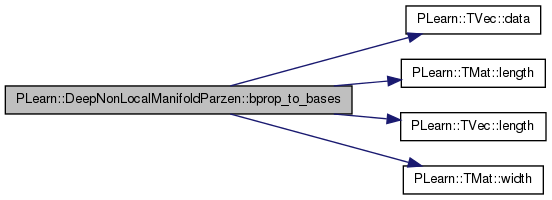

| void PLearn::DeepNonLocalManifoldParzen::build | ( | ) | [virtual] |
Finish building the object; just call inherited::build followed by build_()
Reimplemented from PLearn::PLearner.
Definition at line 465 of file DeepNonLocalManifoldParzen.cc.
References PLearn::PLearner::build(), and build_().
{
inherited::build();
build_();
}

| void PLearn::DeepNonLocalManifoldParzen::build_ | ( | ) | [private] |
This does the actual building.
Reimplemented from PLearn::PLearner.
Definition at line 234 of file DeepNonLocalManifoldParzen.cc.
References all_connections, all_layers, all_output_connections, all_reconstruction_connections, build_layers_and_connections(), PLearn::TVec< T >::clear(), connections, currently_trained_layer, PLearn::TVec< T >::deepCopy(), PLearn::endl(), greedy_stages, i, PLearn::PLearner::inputsize_, k_neighbors, layers, PLearn::TVec< T >::length(), min_sigma_noise, n_classes, n_layers, output_connections, PLERROR, reconstruction_connections, PLearn::TVec< T >::resize(), setTrainingSet(), PLearn::PLearner::stage, test_votes, train_one_network_per_class, PLearn::PLearner::train_set, training_schedule, use_test_centric_nlmp, and PLearn::PLearner::weightsize_.
Referenced by build().
{
// ### This method should do the real building of the object,
// ### according to set 'options', in *any* situation.
// ### Typical situations include:
// ### - Initial building of an object from a few user-specified options
// ### - Building of a "reloaded" object: i.e. from the complete set of
// ### all serialised options.
// ### - Updating or "re-building" of an object after a few "tuning"
// ### options have been modified.
// ### You should assume that the parent class' build_() has already been
// ### called.
MODULE_LOG << "build_() called" << endl;
if(inputsize_ > 0 )
{
// Initialize some learnt variables
n_layers = layers.length();
// Builds some variables using the training set
setTrainingSet(train_set, false);
if( n_classes <= 0 )
PLERROR("DeepNonLocalManifoldParzen::build_() - \n"
"n_classes should be > 0.\n");
test_votes.resize(n_classes);
if( k_neighbors <= 0 )
PLERROR("DeepNonLocalManifoldParzen::build_() - \n"
"k_neighbors should be > 0.\n");
if( weightsize_ > 0 )
PLERROR("DeepNonLocalManifoldParzen::build_() - \n"
"usage of weighted samples (weight size > 0) is not\n"
"implemented yet.\n");
if( training_schedule.length() != n_layers-1 )
PLERROR("DeepNonLocalManifoldParzen::build_() - \n"
"training_schedule should have %d elements.\n",
n_layers-1);
if( n_components < 1 || n_components > inputsize_)
PLERROR("DeepNonLocalManifoldParzen::build_() - \n"
"n_components should be > 0 and < or = to inputsize.\n");
if( min_sigma_noise < 0)
PLERROR("DeepNonLocalManifoldParzen::build_() - \n"
"min_sigma_noise should be > or = to 0.\n");
if( use_test_centric_nlmp && !train_one_network_per_class )
PLERROR("DeepNonLocalManifoldParzen::build_() - \n"
"train_one_network_per_class must be true for "
"Test-Centric NLMP variant.\n");
if( use_test_centric_nlmp && n_classes <= 1)
PLERROR("DeepNonLocalManifoldParzen::build_() - \n"
"n_classes must be > 1 for "
"Test-Centric NLMP variant.\n");
if(greedy_stages.length() == 0)
{
greedy_stages.resize(n_layers-1);
greedy_stages.clear();
}
if(stage > 0)
currently_trained_layer = n_layers;
else
{
currently_trained_layer = n_layers-1;
while(currently_trained_layer>1
&& greedy_stages[currently_trained_layer-1] <= 0)
currently_trained_layer--;
}
build_layers_and_connections();
if( train_one_network_per_class )
{
if( n_classes == 1 )
PLERROR("DeepNonLocalManifoldParzen::build_() - \n"
"train_one_network_per_class is useless for\n"
"n_classes == 1.\n");
if( all_layers.length() != n_classes )
{
all_layers.resize( n_classes);
for( int i=0; i<all_layers.length(); i++ )
{
CopiesMap copies;
all_layers[i] = layers->deepCopy(copies);
}
}
if( all_connections.length() != n_classes )
{
all_connections.resize( n_classes);
for( int i=0; i<all_connections.length(); i++ )
{
CopiesMap copies;
all_connections[i] = connections->deepCopy(copies);
}
}
if( all_reconstruction_connections.length() != n_classes )
{
all_reconstruction_connections.resize( n_classes);
for( int i=0; i<all_reconstruction_connections.length(); i++ )
{
CopiesMap copies;
all_reconstruction_connections[i] =
reconstruction_connections->deepCopy(copies);
}
}
if( all_output_connections.length() != n_classes )
{
all_output_connections.resize( n_classes);
for( int i=0; i<all_output_connections.length(); i++ )
{
CopiesMap copies;
all_output_connections[i] =
output_connections->deepCopy(copies);
}
}
}
}
}


| void PLearn::DeepNonLocalManifoldParzen::build_classification_cost | ( | ) | [private] |
| void PLearn::DeepNonLocalManifoldParzen::build_layers_and_connections | ( | ) | [private] |
Definition at line 361 of file DeepNonLocalManifoldParzen.cc.
References activation_gradients, activations, all_outputs, connections, do_not_learn_sigma_noise, PLearn::endl(), expectation_gradients, expectations, PLearn::fast_exact_is_equal(), greedy_learning_rate, i, PLearn::PLearner::inputsize(), PLearn::PLearner::inputsize_, layers, PLearn::TVec< T >::length(), n_components, n_layers, output_connections, output_connections_l1_penalty_factor, output_connections_l2_penalty_factor, PLERROR, PLearn::PLearner::random_gen, reconstruction_connections, PLearn::TVec< T >::resize(), and PLearn::TVec< T >::size().
Referenced by build_().
{
MODULE_LOG << "build_layers_and_connections() called" << endl;
if( connections.length() != n_layers-1 )
PLERROR("DeepNonLocalManifoldParzen::build_layers_and_connections() - \n"
"there should be %d connections.\n",
n_layers-1);
if( !fast_exact_is_equal( greedy_learning_rate, 0 )
&& reconstruction_connections.length() != n_layers-1 )
PLERROR("DeepNonLocalManifoldParzen::build_layers_and_connections() - \n"
"there should be %d reconstruction connections.\n",
n_layers-1);
if( !( reconstruction_connections.length() == 0
|| reconstruction_connections.length() == n_layers-1 ) )
PLERROR("DeepNonLocalManifoldParzen::build_layers_and_connections() - \n"
"there should be either 0 or %d reconstruction connections.\n",
n_layers-1);
if(layers[0]->size != inputsize_)
PLERROR("DeepNonLocalManifoldParzen::build_layers_and_connections() - \n"
"layers[0] should have a size of %d.\n",
inputsize_);
activations.resize( n_layers );
expectations.resize( n_layers );
activation_gradients.resize( n_layers );
expectation_gradients.resize( n_layers );
for( int i=0 ; i<n_layers-1 ; i++ )
{
if( layers[i]->size != connections[i]->down_size )
PLERROR("DeepNonLocalManifoldParzen::build_layers_and_connections() "
"- \n"
"connections[%i] should have a down_size of %d.\n",
i, layers[i]->size);
if( connections[i]->up_size != layers[i+1]->size )
PLERROR("DeepNonLocalManifoldParzen::build_layers_and_connections() "
"- \n"
"connections[%i] should have a up_size of %d.\n",
i, layers[i+1]->size);
if( !(layers[i]->random_gen) )
{
layers[i]->random_gen = random_gen;
layers[i]->forget();
}
if( !(connections[i]->random_gen) )
{
connections[i]->random_gen = random_gen;
connections[i]->forget();
}
if( reconstruction_connections.length() != 0
&& !(reconstruction_connections[i]->random_gen) )
{
reconstruction_connections[i]->random_gen = random_gen;
reconstruction_connections[i]->forget();
}
activations[i].resize( layers[i]->size );
expectations[i].resize( layers[i]->size );
activation_gradients[i].resize( layers[i]->size );
expectation_gradients[i].resize( layers[i]->size );
}
if( !(layers[n_layers-1]->random_gen) )
{
layers[n_layers-1]->random_gen = random_gen;
layers[n_layers-1]->forget();
}
activations[n_layers-1].resize( layers[n_layers-1]->size );
expectations[n_layers-1].resize( layers[n_layers-1]->size );
activation_gradients[n_layers-1].resize( layers[n_layers-1]->size );
expectation_gradients[n_layers-1].resize( layers[n_layers-1]->size );
int output_size = n_components*inputsize() + inputsize() + (do_not_learn_sigma_noise ? 0 : 1);
all_outputs.resize( output_size );
if( !output_connections || output_connections->output_size != output_size)
{
PP<GradNNetLayerModule> ow = new GradNNetLayerModule;
ow->input_size = layers[n_layers-1]->size;
ow->output_size = output_size;
ow->L1_penalty_factor = output_connections_l1_penalty_factor;
ow->L2_penalty_factor = output_connections_l2_penalty_factor;
ow->random_gen = random_gen;
ow->build();
output_connections = ow;
}
if( !(output_connections->random_gen) )
{
output_connections->random_gen = random_gen;
output_connections->forget();
}
}


| string PLearn::DeepNonLocalManifoldParzen::classname | ( | ) | const [virtual] |
Reimplemented from PLearn::Object.
Definition at line 56 of file DeepNonLocalManifoldParzen.cc.
Referenced by train().

| void PLearn::DeepNonLocalManifoldParzen::computeCostsFromOutputs | ( | const Vec & | input, |
| const Vec & | output, | ||
| const Vec & | target, | ||
| Vec & | costs | ||
| ) | const [virtual] |
Computes the costs from already computed output.
Implements PLearn::PLearner.
Definition at line 1303 of file DeepNonLocalManifoldParzen.cc.
References all_connections, all_layers, all_output_connections, all_reconstruction_connections, c, class_datasets, connections, currently_trained_layer, expectations, PLearn::TVec< T >::fill(), getTestCostNames(), layers, PLearn::TVec< T >::length(), MISSING_VALUE, n_classes, n_layers, output_connections, pl_log, reconstruction_activations, reconstruction_connections, PLearn::TVec< T >::resize(), test_votes, train_one_network_per_class, and use_test_centric_nlmp.
{
//Assumes that computeOutput has been called
costs.resize( getTestCostNames().length() );
costs.fill( MISSING_VALUE );
if( train_one_network_per_class )
{
int c = (int) target[0];
layers = all_layers[c];
connections = all_connections[c];
reconstruction_connections = all_reconstruction_connections[c];
output_connections = all_output_connections[c];
}
if( currently_trained_layer<n_layers
&& reconstruction_connections.length() != 0 )
{
reconstruction_connections[ currently_trained_layer-1 ]->fprop(
expectations[currently_trained_layer],
reconstruction_activations);
layers[ currently_trained_layer-1 ]->fprop(
reconstruction_activations,
layers[ currently_trained_layer-1 ]->expectation);
layers[ currently_trained_layer-1 ]->activation <<
reconstruction_activations;
layers[ currently_trained_layer-1 ]->setExpectationByRef(
layers[ currently_trained_layer-1 ]->expectation);
costs[ currently_trained_layer-1 ] =
layers[ currently_trained_layer-1 ]->fpropNLL(
expectations[currently_trained_layer-1]);
}
else
{
if( n_classes > 1 )
{
int target_class = ((int)round(target[0]));
if( ((int)round(output[0])) == target_class )
costs[n_layers-1] = 0;
else
costs[n_layers-1] = 1;
if( !use_test_centric_nlmp )
costs[n_layers] = - test_votes[target_class]
+pl_log(class_datasets[target_class]->length()); // Must take into account the 1/n normalization
}
else
{
costs[n_layers] = - output[0]; // 1/n normalization already accounted for
}
}
}

| void PLearn::DeepNonLocalManifoldParzen::computeManifoldParzenParameters | ( | const Vec & | input, |
| Mat & | F, | ||
| Vec & | mu, | ||
| Vec & | pre_sigma_noise, | ||
| Mat & | U, | ||
| Vec & | sm_svd, | ||
| int | target_class = -1 |
||
| ) | const |
Definition at line 914 of file DeepNonLocalManifoldParzen.cc.
References all_connections, all_layers, all_output_connections, all_outputs, all_reconstruction_connections, PLearn::TVec< T >::clear(), computeRepresentation(), connections, do_not_learn_sigma_noise, F, F_copy, input_representation, PLearn::PLearner::inputsize(), PLearn::lapackSVD(), layers, PLearn::TMat< T >::length(), PLearn::mypow(), n_components, n_layers, output_connections, PLASSERT, reconstruction_connections, PLearn::TMat< T >::resize(), PLearn::TVec< T >::resize(), S, PLearn::TVec< T >::subVec(), PLearn::TVec< T >::toMat(), train_one_network_per_class, U, Ut, V, and PLearn::TMat< T >::width().
Referenced by computeOutput(), fineTuningStep(), and updateManifoldParzenParameters().
{
if( train_one_network_per_class )
{
PLASSERT( target_class >= 0 );
layers = all_layers[target_class];
connections = all_connections[target_class];
reconstruction_connections = all_reconstruction_connections[target_class];
output_connections = all_output_connections[target_class];
}
// Get example representation
computeRepresentation(input, input_representation,
n_layers-1);
// Get parameters
output_connections->fprop( input_representation, all_outputs );
F.resize(n_components, inputsize());
mu.resize(inputsize());
pre_sigma_noise.resize(1);
F << all_outputs.subVec(0,n_components * inputsize()).toMat(
n_components, inputsize());
mu << all_outputs.subVec(n_components * inputsize(),inputsize());
if( do_not_learn_sigma_noise )
pre_sigma_noise.clear();
else
pre_sigma_noise << all_outputs.subVec( (n_components+1) * inputsize(), 1 );
F_copy.resize(F.length(),F.width());
sm_svd.resize(n_components);
// N.B. this is the SVD of F'
F_copy << F;
lapackSVD(F_copy, Ut, S, V,'A',1.5);
U.resize(n_components,inputsize());
for (int k=0;k<n_components;k++)
{
sm_svd[k] = mypow(S[k],2);
U(k) << Ut(k);
}
}
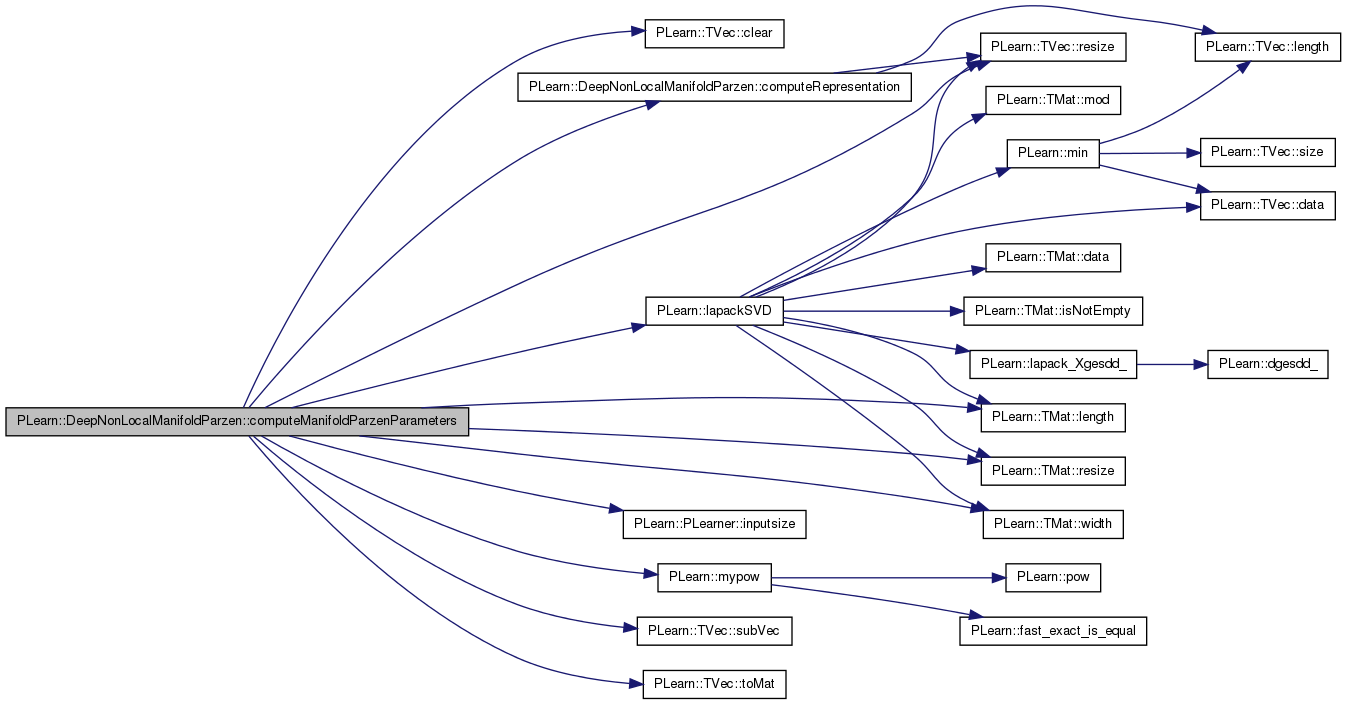

| void PLearn::DeepNonLocalManifoldParzen::computeOutput | ( | const Vec & | input, |
| Vec & | output | ||
| ) | const [virtual] |
Computes the output from the input.
Reimplemented from PLearn::PLearner.
Definition at line 1131 of file DeepNonLocalManifoldParzen.cc.
References PLearn::argmax(), class_datasets, PLearn::TVec< T >::clear(), computeManifoldParzenParameters(), computeRepresentation(), currently_trained_layer, diff, diff_neighbor_input, PLearn::dot(), eigenvalues, eigenvectors, F, PLearn::VMat::getExample(), i, input_representation, PLearn::PLearner::inputsize(), j, PLearn::VMat::length(), PLearn::TVec< T >::length(), Log2Pi, PLearn::logadd(), min_sigma_noise, mu, mus, n, n_classes, n_components, n_layers, pl_log, PLearn::pownorm(), pre_sigma_noise, reconstruction_connections, PLearn::TVec< T >::resize(), save_manifold_parzen_parameters, sigma_noises, sm_svd, PLearn::substract(), PLearn::PLearner::targetsize(), test_votes, PLearn::PLearner::train_set, U, uk, updateManifoldParzenParameters(), and use_test_centric_nlmp.
{
if( currently_trained_layer<n_layers
&& reconstruction_connections.length() != 0 )
{
computeRepresentation(input, input_representation,
currently_trained_layer);
return;
}
test_votes.resize(n_classes);
test_votes.clear();
// Variables for probability computations
real log_p_x_g_y = 0;
real mahal = 0;
real norm_term = 0;
real n = inputsize();
real dotp = 0;
real coef = 0;
real sigma_noise = 0;
Vec input_j(inputsize());
Vec target(targetsize());
real weight;
if( use_test_centric_nlmp )
{
for( int i=0; i<n_classes; i++ )
{
computeManifoldParzenParameters( input, F, mu,
pre_sigma_noise, U, sm_svd,
i);
sigma_noise = pre_sigma_noise[0]*pre_sigma_noise[0]
+ min_sigma_noise;
mahal = -0.5*pownorm(mu)/sigma_noise;
norm_term = - n/2.0 * Log2Pi - 0.5*(n-n_components)*
pl_log(sigma_noise);
for(int k=0; k<n_components; k++)
{
uk = U(k);
dotp = dot(mu,uk);
coef = (1.0/(sm_svd[k]+sigma_noise) - 1.0/sigma_noise);
mahal -= dotp*dotp*0.5*coef;
norm_term -= 0.5*pl_log(sm_svd[k]+sigma_noise);
}
log_p_x_g_y = norm_term + mahal;
test_votes[i] = log_p_x_g_y ;
}
}
else
{
if( save_manifold_parzen_parameters )
{
updateManifoldParzenParameters();
int input_j_index;
for( int i=0; i<n_classes; i++ )
{
for( int j=0;
j<(n_classes > 1 ?
class_datasets[i]->length()
: train_set->length());
j++ )
{
if( n_classes > 1 )
{
class_datasets[i]->getExample(j,input_j,target,weight);
input_j_index = class_datasets[i]->indices[j];
}
else
{
train_set->getExample(j,input_j,target,weight);
input_j_index = j;
}
U << eigenvectors[input_j_index];
sm_svd << eigenvalues(input_j_index);
sigma_noise = sigma_noises[input_j_index];
mu << mus(input_j_index);
substract(input,input_j,diff_neighbor_input);
substract(diff_neighbor_input,mu,diff);
mahal = -0.5*pownorm(diff)/sigma_noise;
norm_term = - n/2.0 * Log2Pi - 0.5*(n-n_components)*
pl_log(sigma_noise);
for(int k=0; k<n_components; k++)
{
uk = U(k);
dotp = dot(diff,uk);
coef = (1.0/(sm_svd[k]+sigma_noise) - 1.0/sigma_noise);
mahal -= dotp*dotp*0.5*coef;
norm_term -= 0.5*pl_log(sm_svd[k]+sigma_noise);
}
if( j==0 )
log_p_x_g_y = norm_term + mahal;
else
log_p_x_g_y = logadd(norm_term + mahal, log_p_x_g_y);
}
test_votes[i] = log_p_x_g_y;
}
}
else
{
for( int i=0; i<n_classes; i++ )
{
for( int j=0;
j<(n_classes > 1 ?
class_datasets[i]->length()
: train_set->length());
j++ )
{
if( n_classes > 1 )
{
class_datasets[i]->getExample(j,input_j,target,weight);
computeManifoldParzenParameters( input_j, F, mu,
pre_sigma_noise, U, sm_svd,
(int) target[0]);
}
else
{
train_set->getExample(j,input_j,target,weight);
computeManifoldParzenParameters( input_j, F, mu,
pre_sigma_noise, U, sm_svd );
}
sigma_noise = pre_sigma_noise[0]*pre_sigma_noise[0]
+ min_sigma_noise;
substract(input,input_j,diff_neighbor_input);
substract(diff_neighbor_input,mu,diff);
mahal = -0.5*pownorm(diff)/sigma_noise;
norm_term = - n/2.0 * Log2Pi - 0.5*(n-n_components)*
pl_log(sigma_noise);
for(int k=0; k<n_components; k++)
{
uk = U(k);
dotp = dot(diff,uk);
coef = (1.0/(sm_svd[k]+sigma_noise) - 1.0/sigma_noise);
mahal -= dotp*dotp*0.5*coef;
norm_term -= 0.5*pl_log(sm_svd[k]+sigma_noise);
}
if( j==0 )
log_p_x_g_y = norm_term + mahal;
else
log_p_x_g_y = logadd(norm_term + mahal, log_p_x_g_y);
}
test_votes[i] = log_p_x_g_y;
}
}
}
if( n_classes > 1 )
output[0] = argmax(test_votes);
else
output[0] = test_votes[0]-pl_log(train_set->length());
}
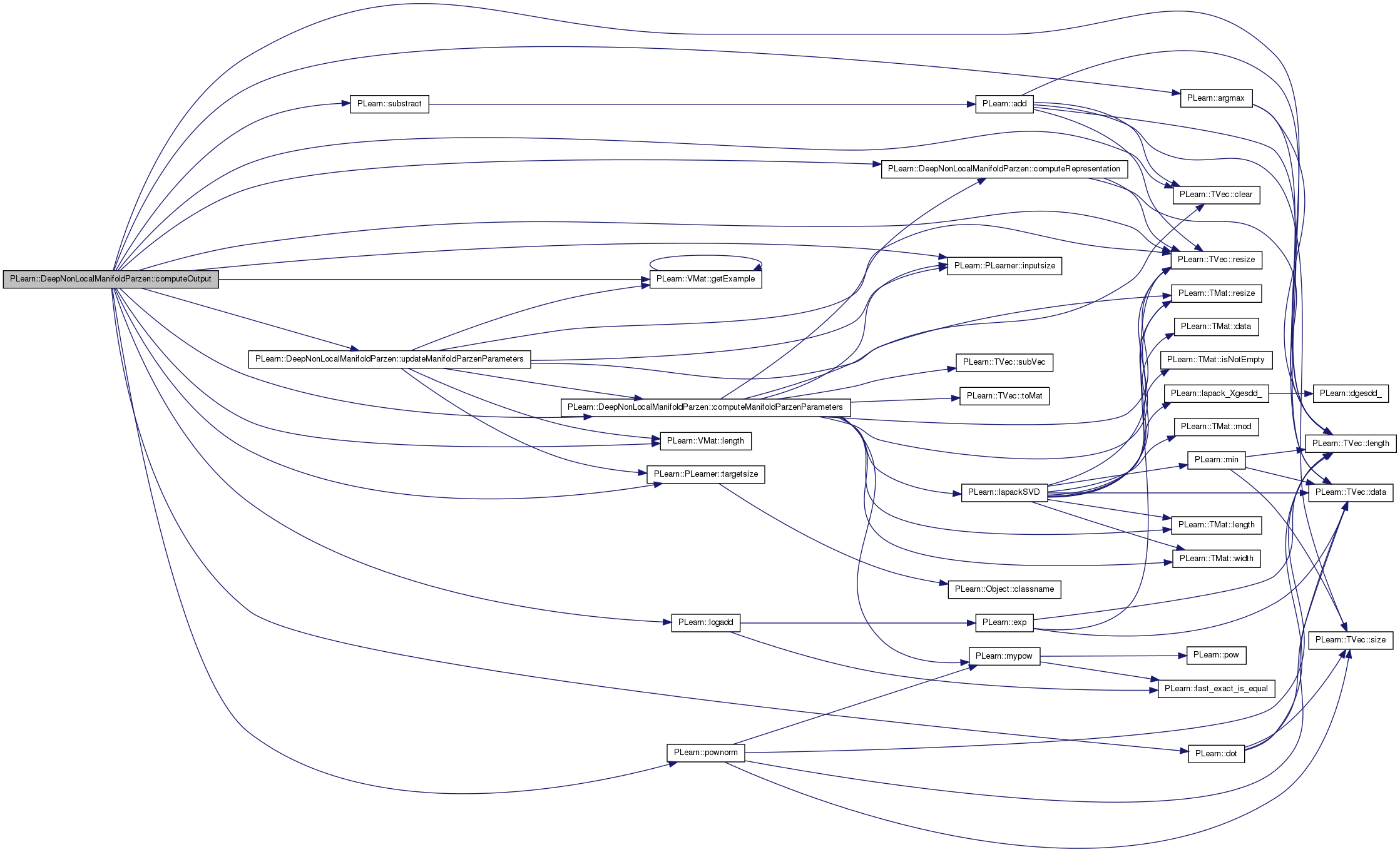
| void PLearn::DeepNonLocalManifoldParzen::computeRepresentation | ( | const Vec & | input, |
| Vec & | representation, | ||
| int | layer | ||
| ) | const |
Definition at line 1109 of file DeepNonLocalManifoldParzen.cc.
References activations, connections, expectations, i, layers, PLearn::TVec< T >::length(), and PLearn::TVec< T >::resize().
Referenced by computeManifoldParzenParameters(), computeOutput(), and greedyStep().
{
if(layer == 0)
{
representation.resize(input.length());
expectations[0] << input;
representation << input;
return;
}
expectations[0] << input;
for( int i=0 ; i<layer; i++ )
{
connections[i]->fprop( expectations[i], activations[i+1] );
layers[i+1]->fprop(activations[i+1],expectations[i+1]);
}
representation.resize(expectations[layer].length());
representation << expectations[layer];
}


| void PLearn::DeepNonLocalManifoldParzen::declareOptions | ( | OptionList & | ol | ) | [static, protected] |
Declares the class options.
Reimplemented from PLearn::PLearner.
Definition at line 82 of file DeepNonLocalManifoldParzen.cc.
References PLearn::OptionBase::buildoption, cd_decrease_ct, cd_learning_rate, connections, PLearn::declareOption(), PLearn::PLearner::declareOptions(), do_not_learn_sigma_noise, fine_tuning_decrease_ct, fine_tuning_learning_rate, greedy_decrease_ct, greedy_learning_rate, greedy_stages, k_neighbors, layers, PLearn::OptionBase::learntoption, min_sigma_noise, n_classes, n_components, n_layers, output_connections, output_connections_l1_penalty_factor, output_connections_l2_penalty_factor, reconstruction_connections, save_manifold_parzen_parameters, train_one_network_per_class, PLearn::PLearner::train_set, training_schedule, and use_test_centric_nlmp.
{
declareOption(ol, "cd_learning_rate",
&DeepNonLocalManifoldParzen::cd_learning_rate,
OptionBase::buildoption,
"The learning rate used during the RBM "
"contrastive divergence training.\n");
declareOption(ol, "cd_decrease_ct",
&DeepNonLocalManifoldParzen::cd_decrease_ct,
OptionBase::buildoption,
"The decrease constant of the learning rate used during "
"the RBMs contrastive\n"
"divergence training. When a hidden layer has finished "
"its training,\n"
"the learning rate is reset to it's initial value.\n");
declareOption(ol, "greedy_learning_rate",
&DeepNonLocalManifoldParzen::greedy_learning_rate,
OptionBase::buildoption,
"The learning rate used during the autoassociator "
"gradient descent training.\n");
declareOption(ol, "greedy_decrease_ct",
&DeepNonLocalManifoldParzen::greedy_decrease_ct,
OptionBase::buildoption,
"The decrease constant of the learning rate used during "
"the autoassociator\n"
"gradient descent training. When a hidden layer has finished "
"its training,\n"
"the learning rate is reset to it's initial value.\n");
declareOption(ol, "fine_tuning_learning_rate",
&DeepNonLocalManifoldParzen::fine_tuning_learning_rate,
OptionBase::buildoption,
"The learning rate used during the fine tuning gradient descent.\n");
declareOption(ol, "fine_tuning_decrease_ct",
&DeepNonLocalManifoldParzen::fine_tuning_decrease_ct,
OptionBase::buildoption,
"The decrease constant of the learning rate used during "
"fine tuning\n"
"gradient descent.\n");
declareOption(ol, "training_schedule",
&DeepNonLocalManifoldParzen::training_schedule,
OptionBase::buildoption,
"Number of examples to use during each phase of greedy pre-training.\n"
"The number of fine-tunig steps is defined by nstages.\n"
);
declareOption(ol, "layers", &DeepNonLocalManifoldParzen::layers,
OptionBase::buildoption,
"The layers of units in the network. The first element\n"
"of this vector should be the input layer and the\n"
"subsequent elements should be the hidden layers. The\n"
"output layer should not be included in layers.\n");
declareOption(ol, "connections", &DeepNonLocalManifoldParzen::connections,
OptionBase::buildoption,
"The weights of the connections between the layers.\n");
declareOption(ol, "reconstruction_connections",
&DeepNonLocalManifoldParzen::reconstruction_connections,
OptionBase::buildoption,
"The reconstruction weights of the autoassociators.\n");
declareOption(ol, "k_neighbors",
&DeepNonLocalManifoldParzen::k_neighbors,
OptionBase::buildoption,
"Number of nearest neighbors to use to learn "
"the manifold structure..\n");
declareOption(ol, "n_components",
&DeepNonLocalManifoldParzen::n_components,
OptionBase::buildoption,
"Dimensionality of the manifold.\n");
declareOption(ol, "min_sigma_noise",
&DeepNonLocalManifoldParzen::min_sigma_noise,
OptionBase::buildoption,
"Minimum value for the noise variance.\n");
declareOption(ol, "n_classes",
&DeepNonLocalManifoldParzen::n_classes,
OptionBase::buildoption,
"Number of classes. If n_classes = 1, learner will output\n"
"log likelihood of a given input. If n_classes > 1,\n"
"classification will be performed.\n");
declareOption(ol, "train_one_network_per_class",
&DeepNonLocalManifoldParzen::train_one_network_per_class,
OptionBase::buildoption,
"Indication that one network per class should be trained.\n");
declareOption(ol, "output_connections_l1_penalty_factor",
&DeepNonLocalManifoldParzen::output_connections_l1_penalty_factor,
OptionBase::buildoption,
"Output weights L1 penalty factor.\n");
declareOption(ol, "output_connections_l2_penalty_factor",
&DeepNonLocalManifoldParzen::output_connections_l2_penalty_factor,
OptionBase::buildoption,
"Output weights L2 penalty factor.\n");
declareOption(ol, "save_manifold_parzen_parameters",
&DeepNonLocalManifoldParzen::save_manifold_parzen_parameters,
OptionBase::buildoption,
"Indication that the parameters for the manifold parzen\n"
"windows estimator should be saved during test, to speed up "
"testing.\n");
declareOption(ol, "do_not_learn_sigma_noise",
&DeepNonLocalManifoldParzen::do_not_learn_sigma_noise,
OptionBase::buildoption,
"Indication that the value of sigma noise should not be learned.\n");
declareOption(ol, "use_test_centric_nlmp",
&DeepNonLocalManifoldParzen::use_test_centric_nlmp,
OptionBase::buildoption,
"Indication that the Test-Centric NLMP variant should "
"be used.\n"
"In this case, train_one_network_per_class must be true.\n");
declareOption(ol, "greedy_stages",
&DeepNonLocalManifoldParzen::greedy_stages,
OptionBase::learntoption,
"Number of training samples seen in the different greedy "
"phases.\n"
);
declareOption(ol, "n_layers", &DeepNonLocalManifoldParzen::n_layers,
OptionBase::learntoption,
"Number of layers.\n"
);
declareOption(ol, "output_connections",
&DeepNonLocalManifoldParzen::output_connections,
OptionBase::learntoption,
"Output weights.\n"
);
declareOption(ol, "train_set",
&DeepNonLocalManifoldParzen::train_set,
OptionBase::learntoption,
"Training set.\n"
);
// Now call the parent class' declareOptions
inherited::declareOptions(ol);
}

| static const PPath& PLearn::DeepNonLocalManifoldParzen::declaringFile | ( | ) | [inline, static] |
Reimplemented from PLearn::PLearner.
Definition at line 211 of file DeepNonLocalManifoldParzen.h.
:
//##### Not Options #####################################################
| DeepNonLocalManifoldParzen * PLearn::DeepNonLocalManifoldParzen::deepCopy | ( | CopiesMap & | copies | ) | const [virtual] |
Reimplemented from PLearn::PLearner.
Definition at line 56 of file DeepNonLocalManifoldParzen.cc.
| void PLearn::DeepNonLocalManifoldParzen::fineTuningStep | ( | const Vec & | input, |
| const Vec & | target, | ||
| Vec & | train_costs, | ||
| Mat | nearest_neighbors | ||
| ) |
Definition at line 960 of file DeepNonLocalManifoldParzen.cc.
References activation_gradients, activations, all_outputs, all_outputs_gradient, bprop_to_bases(), PLearn::TVec< T >::clear(), PLearn::TMat< T >::clear(), computeManifoldParzenParameters(), connections, diff_neighbor_input, do_not_learn_sigma_noise, PLearn::dot(), expectation_gradients, expectations, F, fk, i, input_representation, PLearn::PLearner::inputsize(), inv_Sigma_F, inv_sigma_fk, inv_Sigma_z, inv_sigma_zj, j, k_neighbors, PLearn::TVec< T >::last(), layers, Log2Pi, manifold_parzen_parameters_are_up_to_date, min_sigma_noise, mu, PLearn::multiplyAcc(), n, n_classes, n_components, n_layers, output_connections, pl_log, PLearn::pownorm(), pre_sigma_noise, PLearn::product(), PLearn::TVec< T >::resize(), PLearn::TMat< T >::resize(), sm_svd, PLearn::substract(), PLearn::TVec< T >::subVec(), temp_ncomp, PLearn::TVec< T >::toMat(), U, uk, uk2, z, and zj.
Referenced by train().
{
manifold_parzen_parameters_are_up_to_date = false;
if( n_classes > 1 )
computeManifoldParzenParameters( input, F, mu, pre_sigma_noise, U, sm_svd,
(int)target[0]);
else
computeManifoldParzenParameters( input, F, mu, pre_sigma_noise, U, sm_svd);
real sigma_noise = pre_sigma_noise[0]* pre_sigma_noise[0] + min_sigma_noise;
real mahal = 0;
real norm_term = 0;
real dotp = 0;
real coef = 0;
real n = inputsize();
z.resize(k_neighbors,inputsize());
temp_ncomp.resize(n_components);
inv_Sigma_z.resize(k_neighbors,inputsize());
inv_Sigma_z.clear();
real tr_inv_Sigma = 0;
train_costs.last() = 0;
for(int j=0; j<k_neighbors;j++)
{
zj = z(j);
substract(nearest_neighbors(j),input,diff_neighbor_input);
substract(diff_neighbor_input,mu,zj);
mahal = -0.5*pownorm(zj)/sigma_noise;
norm_term = - n/2.0 * Log2Pi - 0.5*(n-n_components)*pl_log(sigma_noise);
inv_sigma_zj = inv_Sigma_z(j);
inv_sigma_zj << zj;
inv_sigma_zj /= sigma_noise;
if(j==0)
tr_inv_Sigma = n/sigma_noise;
for(int k=0; k<n_components; k++)
{
uk = U(k);
dotp = dot(zj,uk);
coef = (1.0/(sm_svd[k]+sigma_noise) - 1.0/sigma_noise);
multiplyAcc(inv_sigma_zj,uk,dotp*coef);
mahal -= dotp*dotp*0.5*coef;
norm_term -= 0.5*pl_log(sm_svd[k]+sigma_noise);
if(j==0)
tr_inv_Sigma += coef;
}
train_costs.last() += -1*(norm_term + mahal);
}
train_costs.last() /= k_neighbors;
inv_Sigma_F.resize( n_components, inputsize() );
inv_Sigma_F.clear();
for(int k=0; k<n_components; k++)
{
fk = F(k);
inv_sigma_fk = inv_Sigma_F(k);
inv_sigma_fk << fk;
inv_sigma_fk /= sigma_noise;
for(int k2=0; k2<n_components;k2++)
{
uk2 = U(k2);
multiplyAcc(inv_sigma_fk,uk2,
(1.0/(sm_svd[k2]+sigma_noise) - 1.0/sigma_noise)*
dot(fk,uk2));
}
}
all_outputs_gradient.resize((n_components+1) * inputsize()+
(do_not_learn_sigma_noise ? 0 : 1));
all_outputs_gradient.clear();
//coef = 1.0/train_set->length();
coef = 1.0/k_neighbors;
for(int neighbor=0; neighbor<k_neighbors; neighbor++)
{
// dNLL/dF
product(temp_ncomp,F,inv_Sigma_z(neighbor));
bprop_to_bases(all_outputs_gradient.subVec(0,n_components * inputsize()).toMat(n_components,inputsize()),
inv_Sigma_F,
temp_ncomp,inv_Sigma_z(neighbor),
coef);
// dNLL/dmu
multiplyAcc(all_outputs_gradient.subVec(n_components * inputsize(),
inputsize()),
inv_Sigma_z(neighbor),
-coef) ;
if( !do_not_learn_sigma_noise )
{
// dNLL/dsn
all_outputs_gradient[(n_components + 1 )* inputsize()] += coef*
0.5*(tr_inv_Sigma - pownorm(inv_Sigma_z(neighbor))) *
2 * pre_sigma_noise[0];
}
}
// Propagating supervised gradient
output_connections->bpropUpdate( input_representation, all_outputs,
expectation_gradients[n_layers-1],
all_outputs_gradient);
for( int i=n_layers-1 ; i>0 ; i-- )
{
layers[i]->bpropUpdate( activations[i],
expectations[i],
activation_gradients[i],
expectation_gradients[i] );
connections[i-1]->bpropUpdate( expectations[i-1],
activations[i],
expectation_gradients[i-1],
activation_gradients[i] );
}
}
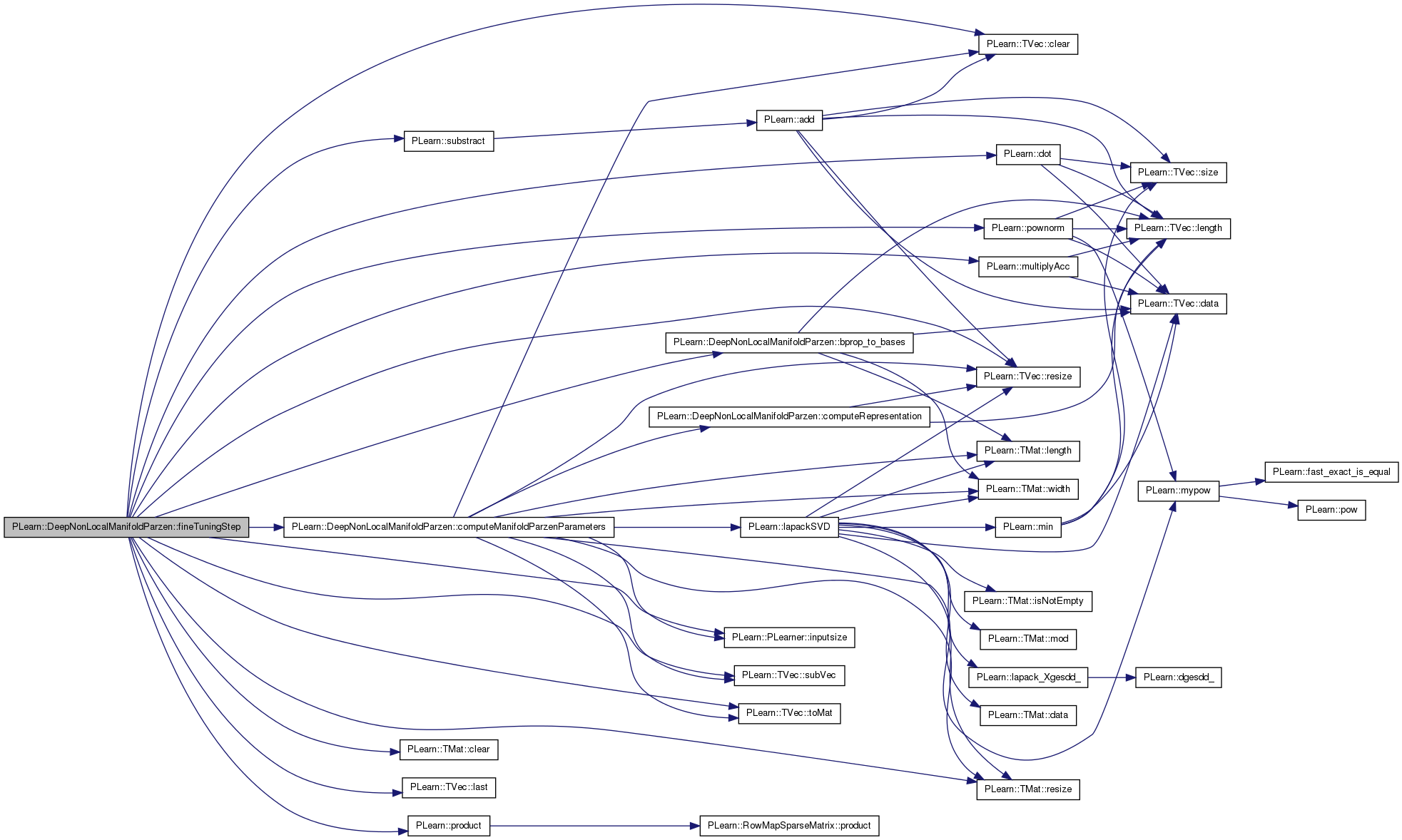

| void PLearn::DeepNonLocalManifoldParzen::forget | ( | ) | [virtual] |
(Re-)initializes the PLearner in its fresh state (that state may depend on the 'seed' option) and sets 'stage' back to 0 (this is the stage of a fresh learner!).
(Re-)initialize the PLearner in its fresh state (that state may depend on the 'seed' option) and sets 'stage' back to 0 (this is the stage of a fresh learner!)
A typical forget() method should do the following:
Reimplemented from PLearn::PLearner.
Definition at line 545 of file DeepNonLocalManifoldParzen.cc.
References all_connections, all_layers, all_output_connections, all_reconstruction_connections, c, PLearn::TVec< T >::clear(), connections, PLearn::PLearner::forget(), greedy_stages, i, layers, PLearn::TVec< T >::length(), manifold_parzen_parameters_are_up_to_date, n_classes, n_layers, output_connections, reconstruction_connections, PLearn::PLearner::stage, and train_one_network_per_class.
{
inherited::forget();
manifold_parzen_parameters_are_up_to_date = false;
if( train_one_network_per_class )
{
for(int c = 0; c<n_classes; c++ )
{
for( int i=0 ; i<n_layers-1 ; i++ )
all_connections[c][i]->forget();
for( int i=0 ; i<n_layers ; i++ )
all_layers[c][i]->forget();
for( int i=0; i<all_reconstruction_connections[c].length(); i++)
all_reconstruction_connections[c][i]->forget();
if( all_output_connections[c] )
all_output_connections[c]->forget();
}
}
else
{
for( int i=0 ; i<n_layers-1 ; i++ )
connections[i]->forget();
for( int i=0 ; i<n_layers ; i++ )
layers[i]->forget();
for( int i=0; i<reconstruction_connections.length(); i++)
reconstruction_connections[i]->forget();
if( output_connections )
output_connections->forget();
}
stage = 0;
greedy_stages.clear();
}

| OptionList & PLearn::DeepNonLocalManifoldParzen::getOptionList | ( | ) | const [virtual] |
Reimplemented from PLearn::Object.
Definition at line 56 of file DeepNonLocalManifoldParzen.cc.
| OptionMap & PLearn::DeepNonLocalManifoldParzen::getOptionMap | ( | ) | const [virtual] |
Reimplemented from PLearn::Object.
Definition at line 56 of file DeepNonLocalManifoldParzen.cc.
| RemoteMethodMap & PLearn::DeepNonLocalManifoldParzen::getRemoteMethodMap | ( | ) | const [virtual] |
Reimplemented from PLearn::Object.
Definition at line 56 of file DeepNonLocalManifoldParzen.cc.
| TVec< string > PLearn::DeepNonLocalManifoldParzen::getTestCostNames | ( | ) | const [virtual] |
Returns the names of the costs computed by computeCostsFromOutpus (and thus the test method).
Implements PLearn::PLearner.
Definition at line 1402 of file DeepNonLocalManifoldParzen.cc.
References PLearn::TVec< T >::append(), i, layers, PLearn::TVec< T >::push_back(), PLearn::TVec< T >::size(), and PLearn::tostring().
Referenced by computeCostsFromOutputs(), and getTrainCostNames().
{
// Return the names of the costs computed by computeCostsFromOutputs
// (these may or may not be exactly the same as what's returned by
// getTrainCostNames).
TVec<string> cost_names(0);
for( int i=0; i<layers.size()-1; i++)
cost_names.push_back("reconstruction_error_" + tostring(i+1));
cost_names.append( "class_error" );
cost_names.append( "NLL" );
return cost_names;
}


| TVec< string > PLearn::DeepNonLocalManifoldParzen::getTrainCostNames | ( | ) | const [virtual] |
Returns the names of the objective costs that the train method computes and for which it updates the VecStatsCollector train_stats.
Implements PLearn::PLearner.
Definition at line 1419 of file DeepNonLocalManifoldParzen.cc.
References PLearn::TVec< T >::append(), and getTestCostNames().
Referenced by train().
{
TVec<string> cost_names = getTestCostNames();
cost_names.append( "NLL_neighbors" );
return cost_names ;
}


| void PLearn::DeepNonLocalManifoldParzen::greedyStep | ( | const Vec & | input, |
| const Vec & | target, | ||
| int | index, | ||
| Vec | train_costs, | ||
| int | stage | ||
| ) |
Definition at line 794 of file DeepNonLocalManifoldParzen.cc.
References activations, cd_decrease_ct, cd_learning_rate, computeRepresentation(), connections, expectations, PLearn::fast_exact_is_equal(), greedy_decrease_ct, greedy_learning_rate, layers, manifold_parzen_parameters_are_up_to_date, n_layers, neg_down_val, neg_up_val, PLASSERT, pos_down_val, pos_up_val, previous_input_representation, reconstruction_activation_gradients, reconstruction_activations, reconstruction_connections, reconstruction_expectation_gradients, and PLearn::sample().
Referenced by train().
{
PLASSERT( index < n_layers );
real lr;
manifold_parzen_parameters_are_up_to_date = false;
// Get example representation
computeRepresentation(input, previous_input_representation,
index);
connections[index]->fprop(previous_input_representation,
activations[index+1]);
layers[index+1]->fprop(activations[index+1],
expectations[index+1]);
// Autoassociator learning
if( !fast_exact_is_equal( greedy_learning_rate, 0 ) )
{
if( !fast_exact_is_equal( greedy_decrease_ct , 0 ) )
lr = greedy_learning_rate/(1 + greedy_decrease_ct
* this_stage);
else
lr = greedy_learning_rate;
layers[index]->setLearningRate( lr );
connections[index]->setLearningRate( lr );
reconstruction_connections[index]->setLearningRate( lr );
layers[index+1]->setLearningRate( lr );
reconstruction_connections[ index ]->fprop( expectations[index+1],
reconstruction_activations);
layers[ index ]->fprop( reconstruction_activations,
layers[ index ]->expectation);
layers[ index ]->activation << reconstruction_activations;
layers[ index ]->setExpectationByRef(layers[ index ]->expectation);
real rec_err = layers[ index ]->fpropNLL(previous_input_representation);
train_costs[index] = rec_err;
layers[ index ]->bpropNLL(previous_input_representation, rec_err,
reconstruction_activation_gradients);
}
// RBM learning
if( !fast_exact_is_equal( cd_learning_rate, 0 ) )
{
layers[index+1]->setExpectation( expectations[index+1] );
layers[index+1]->generateSample();
// accumulate positive stats using the expectation
// we deep-copy because the value will change during negative phase
pos_down_val = expectations[index];
pos_up_val << layers[index+1]->expectation;
// down propagation, starting from a sample of layers[index+1]
connections[index]->setAsUpInput( layers[index+1]->sample );
layers[index]->getAllActivations( connections[index] );
layers[index]->computeExpectation();
layers[index]->generateSample();
// negative phase
connections[index]->setAsDownInput( layers[index]->sample );
layers[index+1]->getAllActivations( connections[index] );
layers[index+1]->computeExpectation();
// accumulate negative stats
// no need to deep-copy because the values won't change before update
neg_down_val = layers[index]->sample;
neg_up_val = layers[index+1]->expectation;
}
// Update hidden layer bias and weights
if( !fast_exact_is_equal( greedy_learning_rate, 0 ) )
{
layers[ index ]->update(reconstruction_activation_gradients);
reconstruction_connections[ index ]->bpropUpdate(
expectations[index+1],
reconstruction_activations,
reconstruction_expectation_gradients,
reconstruction_activation_gradients);
layers[ index+1 ]->bpropUpdate(
activations[index+1],
expectations[index+1],
// reused
reconstruction_activation_gradients,
reconstruction_expectation_gradients);
connections[ index ]->bpropUpdate(
previous_input_representation,
activations[index+1],
reconstruction_expectation_gradients, //reused
reconstruction_activation_gradients);
}
// RBM updates
if( !fast_exact_is_equal( cd_learning_rate, 0 ) )
{
if( !fast_exact_is_equal( cd_decrease_ct , 0 ) )
lr = cd_learning_rate/(1 + cd_decrease_ct
* this_stage);
else
lr = cd_learning_rate;
layers[index]->setLearningRate( lr );
connections[index]->setLearningRate( lr );
layers[index+1]->setLearningRate( lr );
layers[index]->update( pos_down_val, neg_down_val );
connections[index]->update( pos_down_val, pos_up_val,
neg_down_val, neg_up_val );
layers[index+1]->update( pos_up_val, neg_up_val );
}
}


| void PLearn::DeepNonLocalManifoldParzen::makeDeepCopyFromShallowCopy | ( | CopiesMap & | copies | ) | [virtual] |
Transforms a shallow copy into a deep copy.
Reimplemented from PLearn::PLearner.
Definition at line 472 of file DeepNonLocalManifoldParzen.cc.
References activation_gradients, activations, all_connections, all_layers, all_output_connections, all_outputs, all_outputs_gradient, all_reconstruction_connections, class_datasets, connections, PLearn::deepCopyField(), diff, diff_neighbor_input, eigenvalues, eigenvectors, expectation_gradients, expectations, F, F_copy, fk, greedy_stages, input_representation, inv_Sigma_F, inv_sigma_fk, inv_Sigma_z, inv_sigma_zj, layers, PLearn::PLearner::makeDeepCopyFromShallowCopy(), mu, mus, nearest_neighbors_indices, neg_down_val, neg_up_val, output_connections, pos_down_val, pos_up_val, pre_sigma_noise, previous_input_representation, reconstruction_activation_gradients, reconstruction_activations, reconstruction_connections, reconstruction_expectation_gradients, S, sigma_noises, sm_svd, temp_ncomp, test_votes, training_schedule, U, uk, uk2, Ut, V, z, and zj.
{
inherited::makeDeepCopyFromShallowCopy(copies);
// deepCopyField(, copies);
// Public options
deepCopyField(training_schedule, copies);
deepCopyField(layers, copies);
deepCopyField(connections, copies);
deepCopyField(reconstruction_connections, copies);
// Protected options
deepCopyField(activations, copies);
deepCopyField(expectations, copies);
deepCopyField(activation_gradients, copies);
deepCopyField(expectation_gradients, copies);
deepCopyField(reconstruction_activations, copies);
deepCopyField(reconstruction_activation_gradients, copies);
deepCopyField(reconstruction_expectation_gradients, copies);
deepCopyField(output_connections, copies);
deepCopyField(all_layers, copies);
deepCopyField(all_connections, copies);
deepCopyField(all_reconstruction_connections, copies);
deepCopyField(all_output_connections, copies);
deepCopyField(input_representation, copies);
deepCopyField(previous_input_representation, copies);
deepCopyField(all_outputs, copies);
deepCopyField(all_outputs_gradient, copies);
deepCopyField(F, copies);
deepCopyField(F_copy, copies);
deepCopyField(mu, copies);
deepCopyField(pre_sigma_noise, copies);
deepCopyField(Ut, copies);
deepCopyField(U, copies);
deepCopyField(V, copies);
deepCopyField(z, copies);
deepCopyField(inv_Sigma_F, copies);
deepCopyField(inv_Sigma_z, copies);
deepCopyField(temp_ncomp, copies);
deepCopyField(diff_neighbor_input, copies);
deepCopyField(sm_svd, copies);
deepCopyField(S, copies);
deepCopyField(uk, copies);
deepCopyField(fk, copies);
deepCopyField(uk2, copies);
deepCopyField(inv_sigma_zj, copies);
deepCopyField(zj, copies);
deepCopyField(inv_sigma_fk, copies);
deepCopyField(diff, copies);
deepCopyField(pos_down_val, copies);
deepCopyField(pos_up_val, copies);
deepCopyField(neg_down_val, copies);
deepCopyField(neg_up_val, copies);
deepCopyField(eigenvectors, copies);
deepCopyField(eigenvalues, copies);
deepCopyField(sigma_noises, copies);
deepCopyField(mus, copies);
deepCopyField(class_datasets, copies);
deepCopyField(nearest_neighbors_indices, copies);
deepCopyField(test_votes, copies);
deepCopyField(greedy_stages, copies);
}

| int PLearn::DeepNonLocalManifoldParzen::outputsize | ( | ) | const [virtual] |
Returns the size of this learner's output, (which typically may depend on its inputsize(), targetsize() and set options).
Implements PLearn::PLearner.
Definition at line 537 of file DeepNonLocalManifoldParzen.cc.
{
//if(currently_trained_layer < n_layers)
// return layers[currently_trained_layer]->size;
//return layers[n_layers-1]->size;
return 1;
}
| void PLearn::DeepNonLocalManifoldParzen::setLearningRate | ( | real | the_learning_rate | ) | [private] |
Definition at line 1461 of file DeepNonLocalManifoldParzen.cc.
References connections, i, layers, n_layers, and output_connections.
Referenced by train().
{
for( int i=0 ; i<n_layers-1 ; i++ )
{
layers[i]->setLearningRate( the_learning_rate );
connections[i]->setLearningRate( the_learning_rate );
}
layers[n_layers-1]->setLearningRate( the_learning_rate );
output_connections->setLearningRate( the_learning_rate );
}

| void PLearn::DeepNonLocalManifoldParzen::setTrainingSet | ( | VMat | training_set, |
| bool | call_forget = true |
||
| ) | [virtual] |
Declares the training set.
Then calls build() and forget() if necessary. Also sets this learner's inputsize_ targetsize_ weightsize_ from those of the training_set. Note: You shouldn't have to override this in subclasses, except in maybe to forward the call to an underlying learner.
Reimplemented from PLearn::PLearner.
Definition at line 1426 of file DeepNonLocalManifoldParzen.cc.
References class_datasets, manifold_parzen_parameters_are_up_to_date, n_classes, PLearn::TVec< T >::resize(), and PLearn::PLearner::setTrainingSet().
Referenced by build_().
{
inherited::setTrainingSet(training_set,call_forget);
manifold_parzen_parameters_are_up_to_date = false;
// Separate classes
if( n_classes > 1 )
{
class_datasets.resize(n_classes);
for(int k=0; k<n_classes; k++)
{
class_datasets[k] = new ClassSubsetVMatrix();
class_datasets[k]->classes.resize(1);
class_datasets[k]->classes[0] = k;
class_datasets[k]->source = training_set;
class_datasets[k]->build();
}
}
//class_proportions.resize(n_classes);
//class_proportions.fill(0);
//real sum = 0;
//for(int k=0; k<n_classes; k++)
//{
// class_proportions[k] = class_datasets[k]->length();
// sum += class_datasets[k]->length();
//}
//class_proportions /= sum;
}
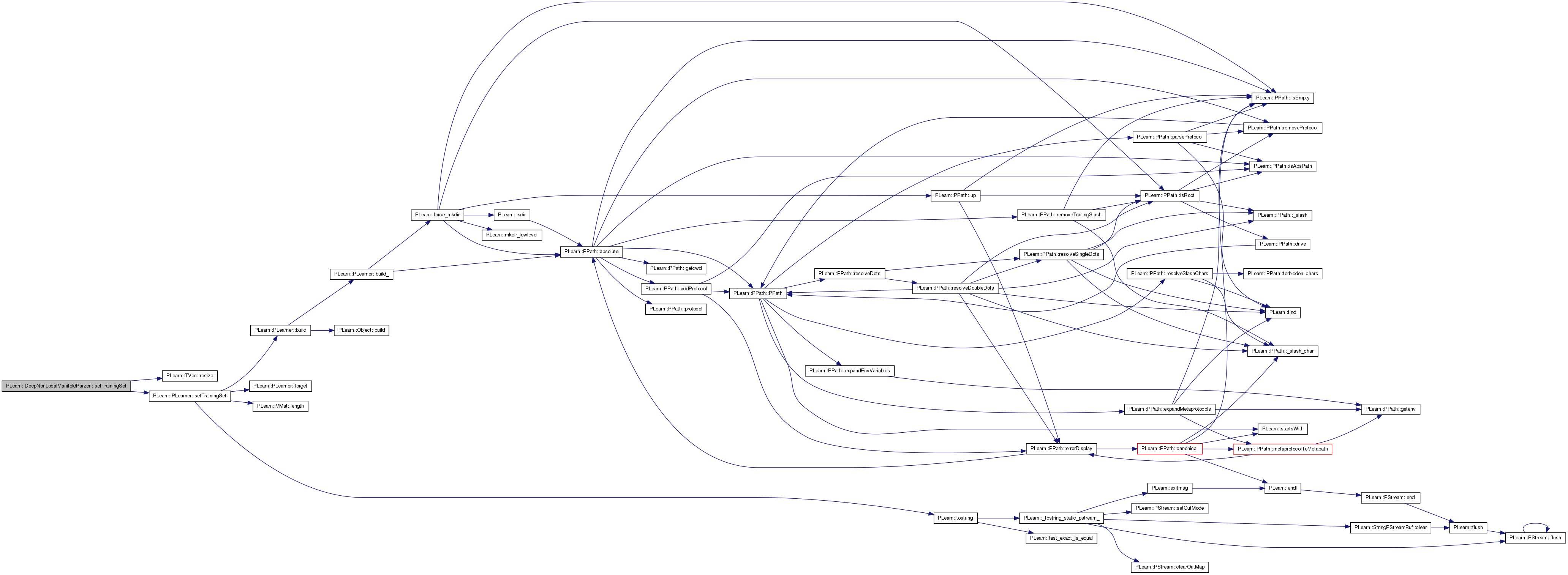

| void PLearn::DeepNonLocalManifoldParzen::train | ( | ) | [virtual] |
The role of the train method is to bring the learner up to stage==nstages, updating the train_stats collector with training costs measured on-line in the process.
Implements PLearn::PLearner.
Definition at line 598 of file DeepNonLocalManifoldParzen.cc.
References all_connections, all_layers, all_output_connections, all_reconstruction_connections, c, class_datasets, classname(), PLearn::computeNearestNeighbors(), connections, currently_trained_layer, PLearn::TVec< T >::data(), PLearn::endl(), PLearn::fast_exact_is_equal(), PLearn::TVec< T >::fill(), fine_tuning_decrease_ct, fine_tuning_learning_rate, fineTuningStep(), PLearn::VMat::getExample(), getTrainCostNames(), greedy_learning_rate, greedy_stages, greedyStep(), i, PLearn::PLearner::inputsize(), k_neighbors, layers, PLearn::VMat::length(), PLearn::TVec< T >::length(), MISSING_VALUE, n_classes, n_layers, nearest_neighbors_indices, neg_down_val, neg_up_val, PLearn::PLearner::nstages, output_connections, PLERROR, pos_down_val, pos_up_val, reconstruction_activation_gradients, reconstruction_activations, reconstruction_connections, reconstruction_expectation_gradients, PLearn::PLearner::report_progress, PLearn::TMat< T >::resize(), PLearn::TVec< T >::resize(), PLearn::sample(), setLearningRate(), PLearn::PLearner::stage, PLearn::TVec< T >::subVec(), PLearn::PLearner::targetsize(), PLearn::tostring(), train_one_network_per_class, PLearn::PLearner::train_set, PLearn::PLearner::train_stats, and training_schedule.
{
MODULE_LOG << "train() called " << endl;
MODULE_LOG << " training_schedule = " << training_schedule << endl;
Vec input( inputsize() );
Vec nearest_neighbor( inputsize() );
Mat nearest_neighbors( k_neighbors, inputsize() );
Vec target( targetsize() );
Vec target2( targetsize() );
real weight; // unused
real weight2; // unused
TVec<string> train_cost_names = getTrainCostNames() ;
Vec train_costs( train_cost_names.length() );
train_costs.fill(MISSING_VALUE) ;
int nsamples = train_set->length();
int sample;
PP<ProgressBar> pb;
// clear stats of previous epoch
train_stats->forget();
int init_stage;
/***** initial greedy training *****/
for( int i=0 ; i<n_layers-1 ; i++ )
{
MODULE_LOG << "Training connection weights between layers " << i
<< " and " << i+1 << endl;
int end_stage = training_schedule[i];
int* this_stage = greedy_stages.subVec(i,1).data();
init_stage = *this_stage;
MODULE_LOG << " stage = " << *this_stage << endl;
MODULE_LOG << " end_stage = " << end_stage << endl;
MODULE_LOG << " greedy_learning_rate = " << greedy_learning_rate << endl;
if( report_progress && *this_stage < end_stage )
pb = new ProgressBar( "Training layer "+tostring(i)
+" of "+classname(),
end_stage - init_stage );
train_costs.fill(MISSING_VALUE);
reconstruction_activations.resize(layers[i]->size);
reconstruction_activation_gradients.resize(layers[i]->size);
reconstruction_expectation_gradients.resize(layers[i]->size);
pos_down_val.resize(layers[i]->size);
pos_up_val.resize(layers[i+1]->size);
neg_down_val.resize(layers[i]->size);
neg_up_val.resize(layers[i+1]->size);
for( ; *this_stage<end_stage ; (*this_stage)++ )
{
sample = *this_stage % nsamples;
train_set->getExample(sample, input, target, weight);
if( train_one_network_per_class )
{
int c = (int) target[0];
layers = all_layers[c];
connections = all_connections[c];
reconstruction_connections = all_reconstruction_connections[c];
output_connections = all_output_connections[c];
}
greedyStep( input, target, i, train_costs, *this_stage);
train_stats->update( train_costs );
if( pb )
pb->update( *this_stage - init_stage + 1 );
}
}
/***** fine-tuning by gradient descent *****/
if( stage < nstages )
{
if( stage == 0 )
{
MODULE_LOG << "Finding the nearest neighbors" << endl;
// Find training nearest neighbors
TVec<int> nearest_neighbors_indices_row;
nearest_neighbors_indices.resize(train_set->length(), k_neighbors);
if( n_classes > 1 )
for(int k=0; k<n_classes; k++)
{
for(int i=0; i<class_datasets[k]->length(); i++)
{
class_datasets[k]->getExample(i,input,target,weight);
nearest_neighbors_indices_row = nearest_neighbors_indices(
class_datasets[k]->indices[i]);
computeNearestNeighbors(
new GetInputVMatrix((VMatrix *)class_datasets[k]),input,
nearest_neighbors_indices_row,
i);
}
}
else
for(int i=0; i<train_set->length(); i++)
{
train_set->getExample(i,input,target,weight);
nearest_neighbors_indices_row = nearest_neighbors_indices(i);
computeNearestNeighbors(
train_set,input,
nearest_neighbors_indices_row,
i);
}
}
MODULE_LOG << "Fine-tuning all parameters, by gradient descent" << endl;
MODULE_LOG << " stage = " << stage << endl;
MODULE_LOG << " nstages = " << nstages << endl;
MODULE_LOG << " fine_tuning_learning_rate = " <<
fine_tuning_learning_rate << endl;
init_stage = stage;
if( report_progress && stage < nstages )
pb = new ProgressBar( "Fine-tuning parameters of all layers of "
+ classname(),
nstages - init_stage );
train_costs.fill(MISSING_VALUE);
for( ; stage<nstages ; stage++ )
{
sample = stage % nsamples;
train_set->getExample( sample, input, target, weight );
// Find nearest neighbors
if( n_classes > 1 )
for( int k=0; k<k_neighbors; k++ )
{
class_datasets[(int)round(target[0])]->getExample(
nearest_neighbors_indices(sample,k),
nearest_neighbor, target2, weight2);
if(round(target[0]) != round(target2[0]))
PLERROR("DeepNonLocalManifoldParzen::train(): similar"
" example is not from same class!");
nearest_neighbors(k) << nearest_neighbor;
}
else
for( int k=0; k<k_neighbors; k++ )
{
train_set->getExample(
nearest_neighbors_indices(sample,k),
nearest_neighbor, target2, weight2);
nearest_neighbors(k) << nearest_neighbor;
}
if( train_one_network_per_class )
{
int c = (int) target[0];
layers = all_layers[c];
connections = all_connections[c];
reconstruction_connections = all_reconstruction_connections[c];
output_connections = all_output_connections[c];
}
if( !fast_exact_is_equal( fine_tuning_decrease_ct, 0. ) )
setLearningRate( fine_tuning_learning_rate
/ (1. + fine_tuning_decrease_ct * stage ) );
else
setLearningRate( fine_tuning_learning_rate );
fineTuningStep( input, target, train_costs,
nearest_neighbors);
train_stats->update( train_costs );
if( pb )
pb->update( stage - init_stage + 1 );
}
}
train_stats->finalize();
MODULE_LOG << " train costs = " << train_stats->getMean() << endl;
// Update currently_trained_layer
if(stage > 0)
currently_trained_layer = n_layers;
else
{
currently_trained_layer = n_layers-1;
while(currently_trained_layer>1
&& greedy_stages[currently_trained_layer-1] <= 0)
currently_trained_layer--;
}
}
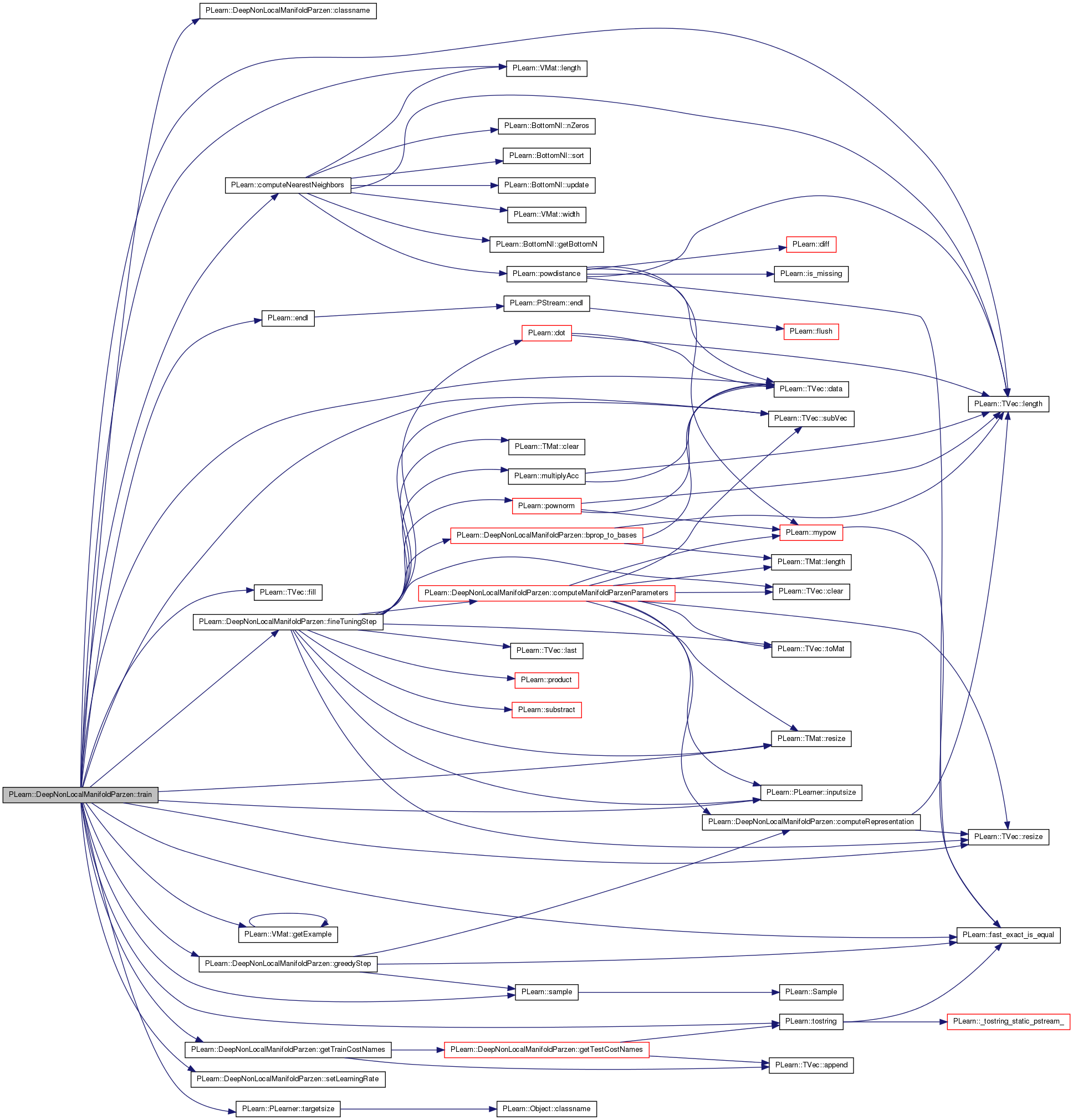
| void PLearn::DeepNonLocalManifoldParzen::updateManifoldParzenParameters | ( | ) | const [virtual] |
Precomputes the representations of the training set examples, to speed up nearest neighbors searches in that space.
Definition at line 1362 of file DeepNonLocalManifoldParzen.cc.
References computeManifoldParzenParameters(), eigenvalues, eigenvectors, F, PLearn::VMat::getExample(), i, PLearn::PLearner::inputsize(), PLearn::VMat::length(), manifold_parzen_parameters_are_up_to_date, min_sigma_noise, mu, mus, n_classes, n_components, pre_sigma_noise, PLearn::TMat< T >::resize(), PLearn::TVec< T >::resize(), sigma_noises, sm_svd, PLearn::PLearner::targetsize(), PLearn::PLearner::train_set, and U.
Referenced by computeOutput().
{
if(!manifold_parzen_parameters_are_up_to_date)
{
// Precompute manifold parzen parameters
Vec input( inputsize() );
Vec target( targetsize() );
real weight;
real sigma_noise;
eigenvectors.resize(train_set->length());
eigenvalues.resize(train_set->length(),n_components);
sigma_noises.resize(train_set->length());
mus.resize(train_set->length(), inputsize());
for( int i=0; i<train_set->length(); i++ )
{
train_set->getExample(i,input,target,weight);
if( n_classes > 1 )
computeManifoldParzenParameters( input, F, mu,
pre_sigma_noise, U, sm_svd,
(int) target[0]);
else
computeManifoldParzenParameters( input, F, mu,
pre_sigma_noise, U, sm_svd);
sigma_noise = pre_sigma_noise[0]*pre_sigma_noise[0] + min_sigma_noise;
eigenvectors[i].resize(n_components,inputsize());
eigenvectors[i] << U;
eigenvalues(i) << sm_svd;
sigma_noises[i] = sigma_noise;
mus(i) << mu;
}
manifold_parzen_parameters_are_up_to_date = true;
}
}
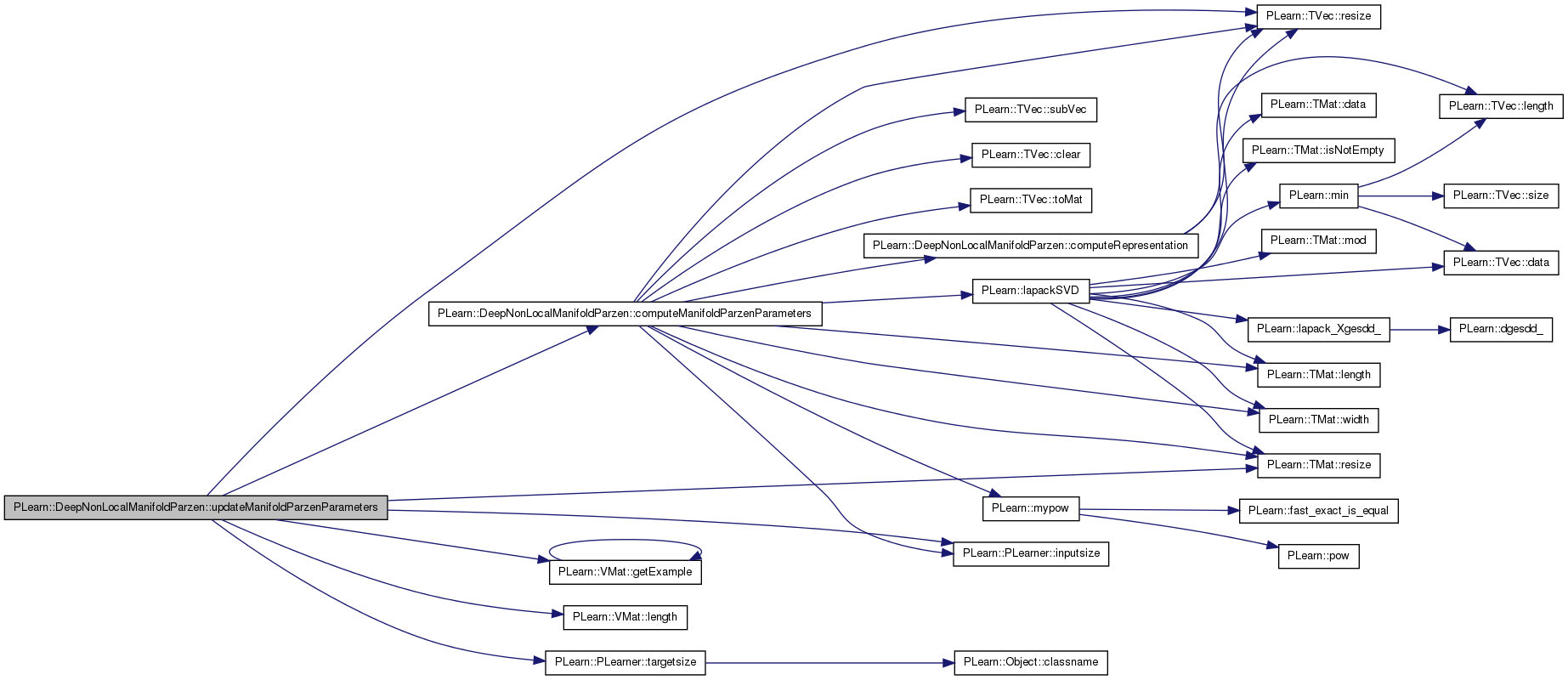

Reimplemented from PLearn::PLearner.
Definition at line 211 of file DeepNonLocalManifoldParzen.h.
TVec<Vec> PLearn::DeepNonLocalManifoldParzen::activation_gradients [mutable, protected] |
Stores the gradient of the cost wrt the activations of the input and hidden layers (at the input of the layers)
Definition at line 234 of file DeepNonLocalManifoldParzen.h.
Referenced by build_layers_and_connections(), fineTuningStep(), and makeDeepCopyFromShallowCopy().
TVec<Vec> PLearn::DeepNonLocalManifoldParzen::activations [mutable, protected] |
Stores the activations of the input and hidden layers (at the input of the layers)
Definition at line 225 of file DeepNonLocalManifoldParzen.h.
Referenced by build_layers_and_connections(), computeRepresentation(), fineTuningStep(), greedyStep(), and makeDeepCopyFromShallowCopy().
TVec< TVec<PP<RBMConnection> > > PLearn::DeepNonLocalManifoldParzen::all_connections [mutable, protected] |
Definition at line 255 of file DeepNonLocalManifoldParzen.h.
Referenced by build_(), computeCostsFromOutputs(), computeManifoldParzenParameters(), forget(), makeDeepCopyFromShallowCopy(), and train().
TVec< TVec< PP<RBMLayer> > > PLearn::DeepNonLocalManifoldParzen::all_layers [mutable, protected] |
Parameters for all networks, when training one network per class.
Definition at line 254 of file DeepNonLocalManifoldParzen.h.
Referenced by build_(), computeCostsFromOutputs(), computeManifoldParzenParameters(), forget(), makeDeepCopyFromShallowCopy(), and train().
TVec< PP<OnlineLearningModule> > PLearn::DeepNonLocalManifoldParzen::all_output_connections [mutable, protected] |
Definition at line 257 of file DeepNonLocalManifoldParzen.h.
Referenced by build_(), computeCostsFromOutputs(), computeManifoldParzenParameters(), forget(), makeDeepCopyFromShallowCopy(), and train().
Vec PLearn::DeepNonLocalManifoldParzen::all_outputs [mutable, protected] |
All outputs that give the components and sigma_noise values.
Definition at line 266 of file DeepNonLocalManifoldParzen.h.
Referenced by build_layers_and_connections(), computeManifoldParzenParameters(), fineTuningStep(), and makeDeepCopyFromShallowCopy().
All outputs' gradients.
Definition at line 269 of file DeepNonLocalManifoldParzen.h.
Referenced by fineTuningStep(), and makeDeepCopyFromShallowCopy().
TVec< TVec<PP<RBMConnection> > > PLearn::DeepNonLocalManifoldParzen::all_reconstruction_connections [mutable, protected] |
Definition at line 256 of file DeepNonLocalManifoldParzen.h.
Referenced by build_(), computeCostsFromOutputs(), computeManifoldParzenParameters(), forget(), makeDeepCopyFromShallowCopy(), and train().
Contrastive divergence decrease constant.
Definition at line 71 of file DeepNonLocalManifoldParzen.h.
Referenced by declareOptions(), and greedyStep().
Contrastive divergence learning rate.
Definition at line 68 of file DeepNonLocalManifoldParzen.h.
Referenced by declareOptions(), and greedyStep().
TVec< PP<ClassSubsetVMatrix> > PLearn::DeepNonLocalManifoldParzen::class_datasets [protected] |
Datasets for each class.
Definition at line 302 of file DeepNonLocalManifoldParzen.h.
Referenced by computeCostsFromOutputs(), computeOutput(), makeDeepCopyFromShallowCopy(), setTrainingSet(), and train().
TVec< PP<RBMConnection> > PLearn::DeepNonLocalManifoldParzen::connections [mutable] |
The weights of the connections between the layers.
Definition at line 96 of file DeepNonLocalManifoldParzen.h.
Referenced by build_(), build_layers_and_connections(), computeCostsFromOutputs(), computeManifoldParzenParameters(), computeRepresentation(), declareOptions(), fineTuningStep(), forget(), greedyStep(), makeDeepCopyFromShallowCopy(), setLearningRate(), and train().
Currently trained layer (1 means the first hidden layer, n_layers means the output layer)
Definition at line 319 of file DeepNonLocalManifoldParzen.h.
Referenced by build_(), computeCostsFromOutputs(), computeOutput(), and train().
Vec PLearn::DeepNonLocalManifoldParzen::diff [mutable, protected] |
Definition at line 279 of file DeepNonLocalManifoldParzen.h.
Referenced by computeOutput(), and makeDeepCopyFromShallowCopy().
Vec PLearn::DeepNonLocalManifoldParzen::diff_neighbor_input [mutable, protected] |
Definition at line 278 of file DeepNonLocalManifoldParzen.h.
Referenced by computeOutput(), fineTuningStep(), and makeDeepCopyFromShallowCopy().
Indication that the value of sigma noise should not be learned.
Definition at line 128 of file DeepNonLocalManifoldParzen.h.
Referenced by build_layers_and_connections(), computeManifoldParzenParameters(), declareOptions(), and fineTuningStep().
Mat PLearn::DeepNonLocalManifoldParzen::eigenvalues [mutable, protected] |
Eigenvalues.
Definition at line 295 of file DeepNonLocalManifoldParzen.h.
Referenced by computeOutput(), makeDeepCopyFromShallowCopy(), and updateManifoldParzenParameters().
TVec<Mat> PLearn::DeepNonLocalManifoldParzen::eigenvectors [mutable, protected] |
Eigenvectors.
Definition at line 293 of file DeepNonLocalManifoldParzen.h.
Referenced by computeOutput(), makeDeepCopyFromShallowCopy(), and updateManifoldParzenParameters().
TVec<Vec> PLearn::DeepNonLocalManifoldParzen::expectation_gradients [mutable, protected] |
Stores the gradient of the cost wrt the expectations of the input and hidden layers (at the output of the layers)
Definition at line 239 of file DeepNonLocalManifoldParzen.h.
Referenced by build_layers_and_connections(), fineTuningStep(), and makeDeepCopyFromShallowCopy().
TVec<Vec> PLearn::DeepNonLocalManifoldParzen::expectations [mutable, protected] |
Stores the expectations of the input and hidden layers (at the output of the layers)
Definition at line 229 of file DeepNonLocalManifoldParzen.h.
Referenced by build_layers_and_connections(), computeCostsFromOutputs(), computeRepresentation(), fineTuningStep(), greedyStep(), and makeDeepCopyFromShallowCopy().
Mat PLearn::DeepNonLocalManifoldParzen::F [mutable, protected] |
Variables for density of a Gaussian.
Definition at line 272 of file DeepNonLocalManifoldParzen.h.
Referenced by computeManifoldParzenParameters(), computeOutput(), fineTuningStep(), makeDeepCopyFromShallowCopy(), and updateManifoldParzenParameters().
Mat PLearn::DeepNonLocalManifoldParzen::F_copy [mutable, protected] |
Definition at line 272 of file DeepNonLocalManifoldParzen.h.
Referenced by computeManifoldParzenParameters(), and makeDeepCopyFromShallowCopy().
The decrease constant of the learning rate used during fine tuning gradient descent.
Definition at line 86 of file DeepNonLocalManifoldParzen.h.
Referenced by declareOptions(), and train().
The learning rate used during the fine tuning gradient descent.
Definition at line 82 of file DeepNonLocalManifoldParzen.h.
Referenced by declareOptions(), and train().
Vec PLearn::DeepNonLocalManifoldParzen::fk [mutable, protected] |
Definition at line 279 of file DeepNonLocalManifoldParzen.h.
Referenced by fineTuningStep(), and makeDeepCopyFromShallowCopy().
The decrease constant of the learning rate used during the autoassociator gradient descent training.
When a hidden layer has finished its training, the learning rate is reset to it's initial value.
Definition at line 79 of file DeepNonLocalManifoldParzen.h.
Referenced by declareOptions(), and greedyStep().
The learning rate used during the autoassociator gradient descent training.
Definition at line 74 of file DeepNonLocalManifoldParzen.h.
Referenced by build_layers_and_connections(), declareOptions(), greedyStep(), and train().
TVec<int> PLearn::DeepNonLocalManifoldParzen::greedy_stages [protected] |
Stages of the different greedy phases.
Definition at line 315 of file DeepNonLocalManifoldParzen.h.
Referenced by build_(), declareOptions(), forget(), makeDeepCopyFromShallowCopy(), and train().
Vec PLearn::DeepNonLocalManifoldParzen::input_representation [mutable, protected] |
Example representation.
Definition at line 260 of file DeepNonLocalManifoldParzen.h.
Referenced by computeManifoldParzenParameters(), computeOutput(), fineTuningStep(), and makeDeepCopyFromShallowCopy().
Mat PLearn::DeepNonLocalManifoldParzen::inv_Sigma_F [mutable, protected] |
Definition at line 277 of file DeepNonLocalManifoldParzen.h.
Referenced by fineTuningStep(), and makeDeepCopyFromShallowCopy().
Vec PLearn::DeepNonLocalManifoldParzen::inv_sigma_fk [mutable, protected] |
Definition at line 279 of file DeepNonLocalManifoldParzen.h.
Referenced by fineTuningStep(), and makeDeepCopyFromShallowCopy().
Mat PLearn::DeepNonLocalManifoldParzen::inv_Sigma_z [mutable, protected] |
Definition at line 277 of file DeepNonLocalManifoldParzen.h.
Referenced by fineTuningStep(), and makeDeepCopyFromShallowCopy().
Vec PLearn::DeepNonLocalManifoldParzen::inv_sigma_zj [mutable, protected] |
Definition at line 279 of file DeepNonLocalManifoldParzen.h.
Referenced by fineTuningStep(), and makeDeepCopyFromShallowCopy().
Number of nearest neighbors to use to learn the manifold structure.
Definition at line 103 of file DeepNonLocalManifoldParzen.h.
Referenced by build_(), declareOptions(), fineTuningStep(), and train().
TVec< PP<RBMLayer> > PLearn::DeepNonLocalManifoldParzen::layers [mutable] |
The layers of units in the network.
Definition at line 93 of file DeepNonLocalManifoldParzen.h.
Referenced by build_(), build_layers_and_connections(), computeCostsFromOutputs(), computeManifoldParzenParameters(), computeRepresentation(), declareOptions(), fineTuningStep(), forget(), getTestCostNames(), greedyStep(), makeDeepCopyFromShallowCopy(), setLearningRate(), and train().
bool PLearn::DeepNonLocalManifoldParzen::manifold_parzen_parameters_are_up_to_date [mutable, protected] |
Indication that the saved manifold parzen parameters are up to date.
Definition at line 322 of file DeepNonLocalManifoldParzen.h.
Referenced by fineTuningStep(), forget(), greedyStep(), setTrainingSet(), and updateManifoldParzenParameters().
Minimum value for the noise variance.
Definition at line 109 of file DeepNonLocalManifoldParzen.h.
Referenced by build_(), computeOutput(), declareOptions(), fineTuningStep(), and updateManifoldParzenParameters().
Vec PLearn::DeepNonLocalManifoldParzen::mu [mutable, protected] |
Definition at line 273 of file DeepNonLocalManifoldParzen.h.
Referenced by computeOutput(), fineTuningStep(), makeDeepCopyFromShallowCopy(), and updateManifoldParzenParameters().
Mat PLearn::DeepNonLocalManifoldParzen::mus [mutable, protected] |
Mus.
Definition at line 299 of file DeepNonLocalManifoldParzen.h.
Referenced by computeOutput(), makeDeepCopyFromShallowCopy(), and updateManifoldParzenParameters().
Number of classes.
Definition at line 112 of file DeepNonLocalManifoldParzen.h.
Referenced by build_(), computeCostsFromOutputs(), computeOutput(), declareOptions(), fineTuningStep(), forget(), setTrainingSet(), train(), and updateManifoldParzenParameters().
Dimensionality of the manifold.
Definition at line 106 of file DeepNonLocalManifoldParzen.h.
Referenced by build_layers_and_connections(), computeManifoldParzenParameters(), computeOutput(), declareOptions(), fineTuningStep(), and updateManifoldParzenParameters().
Number of layers.
Definition at line 137 of file DeepNonLocalManifoldParzen.h.
Referenced by build_(), build_layers_and_connections(), computeCostsFromOutputs(), computeManifoldParzenParameters(), computeOutput(), declareOptions(), fineTuningStep(), forget(), greedyStep(), setLearningRate(), and train().
Proportions of examples from the other classes (columns), for each class (rows)
Nearest neighbors for each training example
Definition at line 309 of file DeepNonLocalManifoldParzen.h.
Referenced by makeDeepCopyFromShallowCopy(), and train().
Vec PLearn::DeepNonLocalManifoldParzen::neg_down_val [protected] |
Negative down statistic.
Definition at line 286 of file DeepNonLocalManifoldParzen.h.
Referenced by greedyStep(), makeDeepCopyFromShallowCopy(), and train().
Vec PLearn::DeepNonLocalManifoldParzen::neg_up_val [protected] |
Negative up statistic.
Definition at line 288 of file DeepNonLocalManifoldParzen.h.
Referenced by greedyStep(), makeDeepCopyFromShallowCopy(), and train().
PP<OnlineLearningModule> PLearn::DeepNonLocalManifoldParzen::output_connections [mutable, protected] |
Output weights.
Definition at line 251 of file DeepNonLocalManifoldParzen.h.
Referenced by build_(), build_layers_and_connections(), computeCostsFromOutputs(), computeManifoldParzenParameters(), declareOptions(), fineTuningStep(), forget(), makeDeepCopyFromShallowCopy(), setLearningRate(), and train().
Output weights L1 penalty factor.
Definition at line 118 of file DeepNonLocalManifoldParzen.h.
Referenced by build_layers_and_connections(), and declareOptions().
Output weights L2 penalty factor.
Definition at line 121 of file DeepNonLocalManifoldParzen.h.
Referenced by build_layers_and_connections(), and declareOptions().
Vec PLearn::DeepNonLocalManifoldParzen::pos_down_val [protected] |
Positive down statistic.
Definition at line 282 of file DeepNonLocalManifoldParzen.h.
Referenced by greedyStep(), makeDeepCopyFromShallowCopy(), and train().
Vec PLearn::DeepNonLocalManifoldParzen::pos_up_val [protected] |
Positive up statistic.
Definition at line 284 of file DeepNonLocalManifoldParzen.h.
Referenced by greedyStep(), makeDeepCopyFromShallowCopy(), and train().
Vec PLearn::DeepNonLocalManifoldParzen::pre_sigma_noise [mutable, protected] |
Definition at line 274 of file DeepNonLocalManifoldParzen.h.
Referenced by computeOutput(), fineTuningStep(), makeDeepCopyFromShallowCopy(), and updateManifoldParzenParameters().
Example representation at the previous layer, in a greedy step.
Definition at line 263 of file DeepNonLocalManifoldParzen.h.
Referenced by greedyStep(), and makeDeepCopyFromShallowCopy().
Vec PLearn::DeepNonLocalManifoldParzen::reconstruction_activation_gradients [mutable, protected] |
Reconstruction activation gradients.
Definition at line 245 of file DeepNonLocalManifoldParzen.h.
Referenced by greedyStep(), makeDeepCopyFromShallowCopy(), and train().
Vec PLearn::DeepNonLocalManifoldParzen::reconstruction_activations [mutable, protected] |
Reconstruction activations.
Definition at line 242 of file DeepNonLocalManifoldParzen.h.
Referenced by computeCostsFromOutputs(), greedyStep(), makeDeepCopyFromShallowCopy(), and train().
The reconstruction weights of the autoassociators.
Definition at line 99 of file DeepNonLocalManifoldParzen.h.
Referenced by build_(), build_layers_and_connections(), computeCostsFromOutputs(), computeManifoldParzenParameters(), computeOutput(), declareOptions(), forget(), greedyStep(), makeDeepCopyFromShallowCopy(), and train().
Vec PLearn::DeepNonLocalManifoldParzen::reconstruction_expectation_gradients [mutable, protected] |
Reconstruction expectation gradients.
Definition at line 248 of file DeepNonLocalManifoldParzen.h.
Referenced by greedyStep(), makeDeepCopyFromShallowCopy(), and train().
Vec PLearn::DeepNonLocalManifoldParzen::S [mutable, protected] |
Definition at line 278 of file DeepNonLocalManifoldParzen.h.
Referenced by computeManifoldParzenParameters(), and makeDeepCopyFromShallowCopy().
Indication that the parameters for the manifold parzen windows estimator should be saved during test, to speed up testing.
Definition at line 125 of file DeepNonLocalManifoldParzen.h.
Referenced by computeOutput(), and declareOptions().
Vec PLearn::DeepNonLocalManifoldParzen::sigma_noises [mutable, protected] |
Sigma noises.
Definition at line 297 of file DeepNonLocalManifoldParzen.h.
Referenced by computeOutput(), makeDeepCopyFromShallowCopy(), and updateManifoldParzenParameters().
Vec PLearn::DeepNonLocalManifoldParzen::sm_svd [mutable, protected] |
Definition at line 278 of file DeepNonLocalManifoldParzen.h.
Referenced by computeOutput(), fineTuningStep(), makeDeepCopyFromShallowCopy(), and updateManifoldParzenParameters().
Vec PLearn::DeepNonLocalManifoldParzen::temp_ncomp [mutable, protected] |
Definition at line 278 of file DeepNonLocalManifoldParzen.h.
Referenced by fineTuningStep(), and makeDeepCopyFromShallowCopy().
Vec PLearn::DeepNonLocalManifoldParzen::test_votes [mutable, protected] |
Nearest neighbor votes for test example.
Definition at line 312 of file DeepNonLocalManifoldParzen.h.
Referenced by build_(), computeCostsFromOutputs(), computeOutput(), and makeDeepCopyFromShallowCopy().
Indication that one network per class should be trained.
Definition at line 115 of file DeepNonLocalManifoldParzen.h.
Referenced by build_(), computeCostsFromOutputs(), computeManifoldParzenParameters(), declareOptions(), forget(), and train().
Number of examples to use during each phase of greedy pre-training.
The number of fine-tunig steps is defined by nstages.
Definition at line 90 of file DeepNonLocalManifoldParzen.h.
Referenced by build_(), declareOptions(), makeDeepCopyFromShallowCopy(), and train().
Mat PLearn::DeepNonLocalManifoldParzen::U [mutable, protected] |
Definition at line 277 of file DeepNonLocalManifoldParzen.h.
Referenced by computeManifoldParzenParameters(), computeOutput(), fineTuningStep(), makeDeepCopyFromShallowCopy(), and updateManifoldParzenParameters().
Vec PLearn::DeepNonLocalManifoldParzen::uk [mutable, protected] |
Definition at line 279 of file DeepNonLocalManifoldParzen.h.
Referenced by computeOutput(), fineTuningStep(), and makeDeepCopyFromShallowCopy().
Vec PLearn::DeepNonLocalManifoldParzen::uk2 [mutable, protected] |
Definition at line 279 of file DeepNonLocalManifoldParzen.h.
Referenced by fineTuningStep(), and makeDeepCopyFromShallowCopy().
Indication that the Test-Centric NLMP variant should be used.
In this case, train_one_network_per_class must be true.
Definition at line 132 of file DeepNonLocalManifoldParzen.h.
Referenced by build_(), computeCostsFromOutputs(), computeOutput(), and declareOptions().
Mat PLearn::DeepNonLocalManifoldParzen::Ut [mutable, protected] |
Variables for the SVD and gradient computation.
Definition at line 277 of file DeepNonLocalManifoldParzen.h.
Referenced by computeManifoldParzenParameters(), and makeDeepCopyFromShallowCopy().
Mat PLearn::DeepNonLocalManifoldParzen::V [mutable, protected] |
Definition at line 277 of file DeepNonLocalManifoldParzen.h.
Referenced by computeManifoldParzenParameters(), and makeDeepCopyFromShallowCopy().
Mat PLearn::DeepNonLocalManifoldParzen::z [mutable, protected] |
Definition at line 277 of file DeepNonLocalManifoldParzen.h.
Referenced by fineTuningStep(), and makeDeepCopyFromShallowCopy().
Vec PLearn::DeepNonLocalManifoldParzen::zj [mutable, protected] |
Definition at line 279 of file DeepNonLocalManifoldParzen.h.
Referenced by fineTuningStep(), and makeDeepCopyFromShallowCopy().
 1.7.4
1.7.4